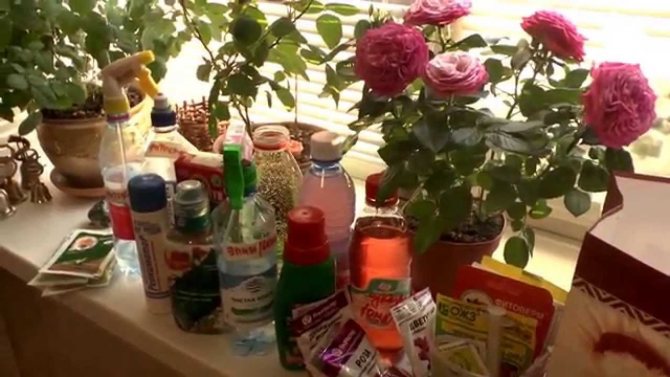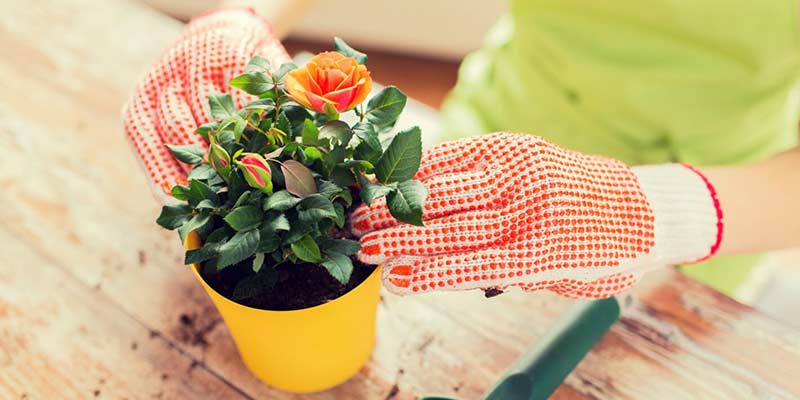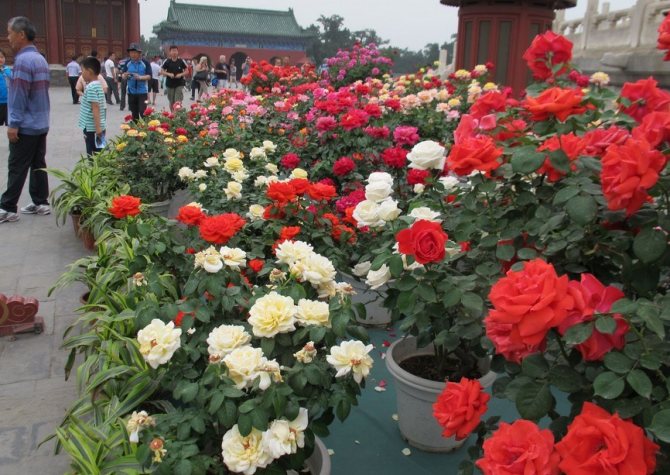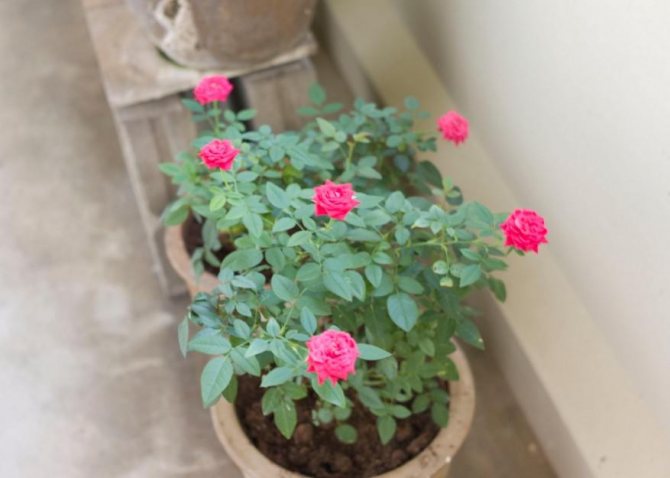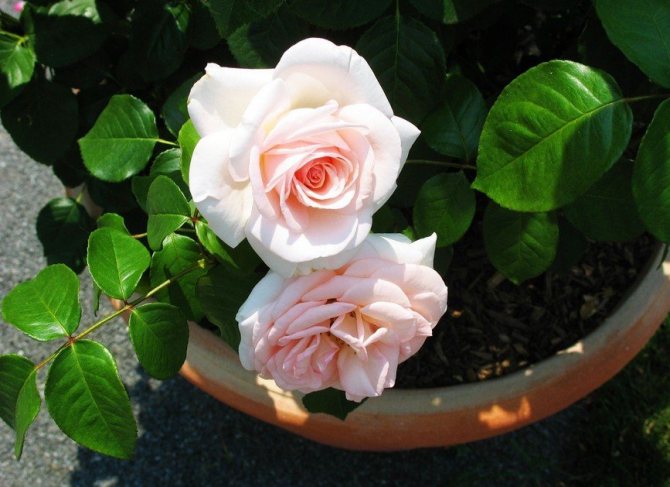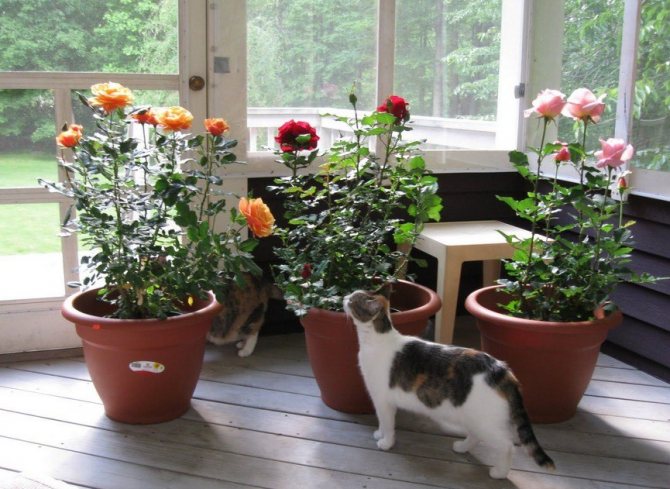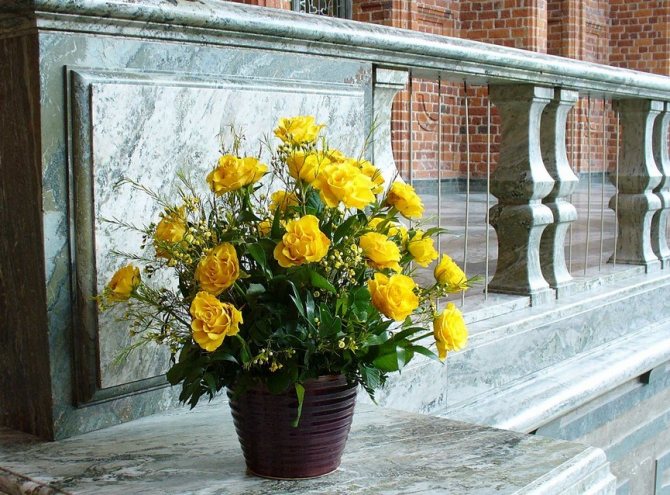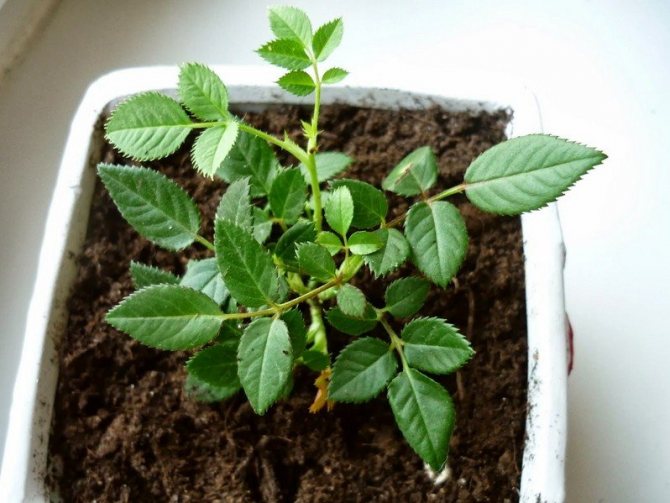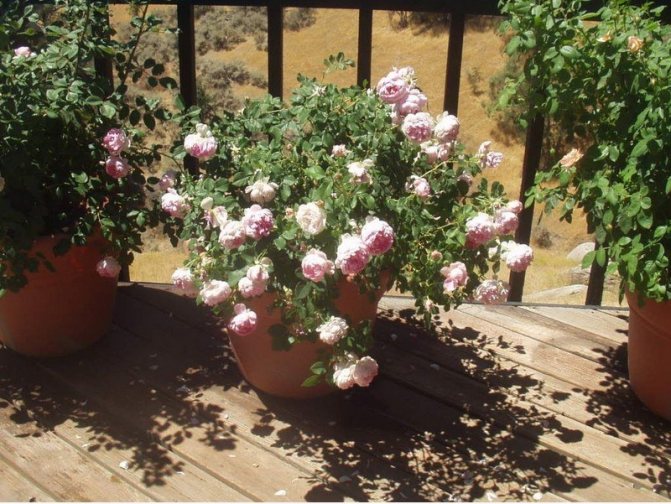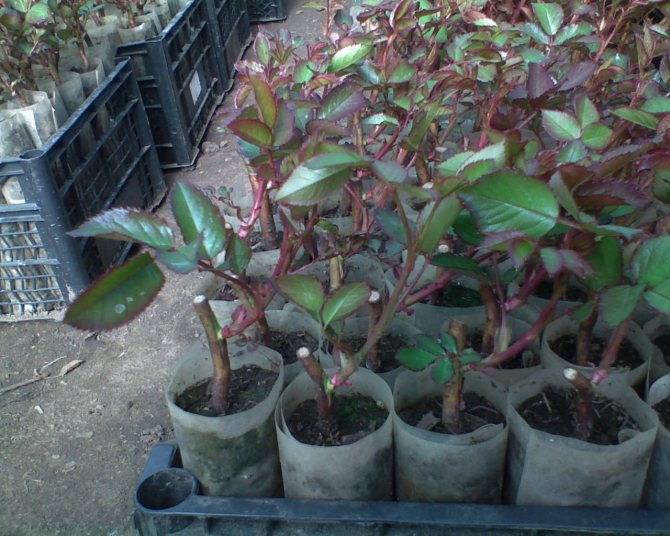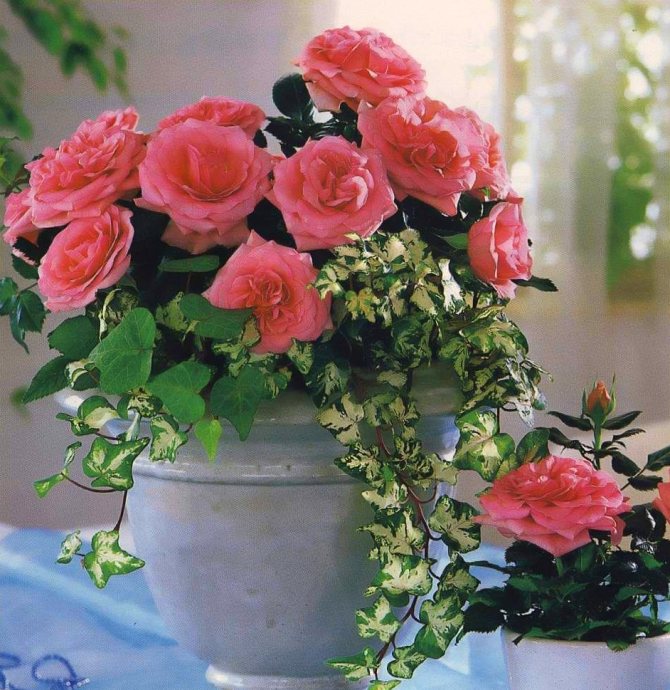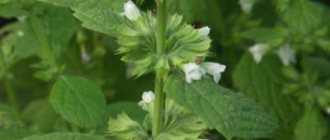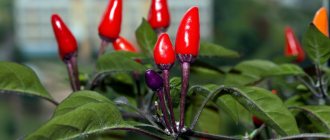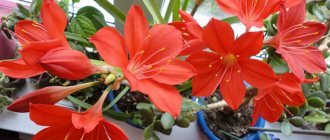Home bush rose in a pot is a very beautiful and capricious plant. It can bloom almost all year round, but for this you need to properly care for it. Florists have long noted that all indoor varieties of roses differ from garden ones not only in size, but also in whimsicality. That is why this plant should be started at home only by those people who are ready to give proper care.
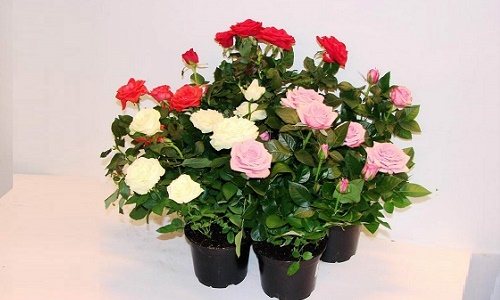
Proper care of a room rose will allow you to preserve the decorative effect of the purchased bush for several years.
Shrub rose in a pot: growing and care at home
The popularity of spray roses for home growing is growing every day. The flower is not so picky about care, it can take root almost anywhere, as long as there is sufficient sunlight and timely supply of moisture and nutrients. The shrub rose is an ideal ornamental plant to add to the home collection of violets, azaleas and balsam.
Despite the fact that amateur gardeners have practically no complaints about the garden bush rose, at home such a simple but incredibly beautiful plant behaves a little differently. In this case, it will be inappropriate to use your knowledge in caring for a garden rose - only a number of requirements in home and garden cultivation will coincide.
How to grow a rose from a cutting
This method is considered the most effective and effective for any varieties of roses, varieties, whose ancestors were rose hips, are especially good at home. This is originally a wild plant, a fallen branch of which instantly germinated even on not the most fertile soil. That is why his descendants take root at home by cuttings from a bouquet much faster, in contrast to artificially selected species.
Indoor rose will become a magnificent element of your interior decor
What roses should not be rooted at home:
- tea European;
- hybrids from South America;
- Dutch long-stemmed.
These are capricious and complex flowers that require the use of special skills - budding. Here you need to be able to implant buds into the growing branches of the rose hips, taking into account the seasonal characteristics. In addition, they are distinguished by especially long periods of transportation, in order to preserve life and freshness, the plants are treated with special preparations, which reduces to a minimum the probability of successful removal by cuttings from the bouquet. And the likelihood of growing such a rose from a cutting is not only at home, but even according to all the rules in a greenhouse, it comes down to 10%, not a single most competent and detailed video will help here, a plantation and an appropriate climate will be required.
Gorgeous black rose Halfeti
Season:
It is necessary to start preparing correctly from the moment the rose fell into the hands and the vase. If you have ever grown them yourself or want to take them from friends from the garden, it is best to do this in the fall, if we want to give life to a flower from a bouquet at home, the season does not matter, you can root it at any time of the year. However, experienced breeders claim that nature tells us with its entire existence that all plants germinate best in spring.
If you liked a rose from a bouquet, then you can give it a second life by cutting and planting its stalk.
Procedure:
- Choose a few roses from the bouquet, cut off the buds, remove the thorns and completely immerse the stems in water for a day.
- With a sharp knife or scissors, cut the stem obliquely at an angle, which will prevent air from entering the cut. But it's not that simple - you need to cut in the right places. The stalk should be at least 10 cm long and have at least one bud; ideally, the lower cut should be made in the middle between the nodes, and the upper cut just above the bud should not be longer than 1 cm and sprinkle with crushed activated carbon. The bottom of the cutting is cut crosswise with a knife no deeper than 8 mm. The bottom cut is treated with a root growth stimulant that can be purchased at any gardening store.
- We put it in a vase of water and cover it with a plastic bag, many gardeners add a couple of drops of honey there, since it is a good biostimulant or their chemical versions. We do not change the water, we just defend it and pour it into the vase as it evaporates. There is another option - you can place the cutting directly into the soil, the main thing is not to forget to water it regularly so that the soil always remains moist.
- When roots appear in the water, we plant them in a pot, with the option of rooting immediately in the ground, we just wait for the result.
Rooting the cuttings directly into the ground
Advice! Before placing the cuttings in the soil, it is worthwhile to first make drainage in the pot - pour special pebbles. In order for the stalk to grow quickly and correctly, it is even worth building a mini-greenhouse in a pot at home - a kind of greenhouse on a wire frame, covered with polyethylene. How to arrange it can be found on the video on the Internet.
So that the soil is not waterlogged, it is necessary to make drainage
What you should know about home bush rose
Optimal temperature, lighting and watering
Like any other light-loving plant, a flower pot with a rose should be placed on the south side by the window. It will be quite wonderful if the plant gets not only access to the sun's rays, but also to fresh air.
Low temperatures will kill the plant. Therefore, if the glass unit is thin enough, but the windows are not, no, but covered with frost, during the winter season, you should transfer the flower inhabitant to another window or to a curbstone near it. Fresh, nutritious soil is the key to a healthy flowering plant.
Transplanting a plant from one pot to another is not worth it. Unless in an urgent need. In order not to disturb the rose once again, you should initially choose a roomy pot or a wide container.
Systematic feeding. The event should be carried out no more than once every 5-7 days. During the flowering period, you may need to feed the plant a little more often than usual (for example, by reducing the one-time dose, but increasing the number of times a week). Vegetation of the plant (the season when the intensity of growth and development of the decorative rose is increased).
Is it possible to grow roses at home in a pot
Hello dear friends!
Growing the queen of flowers - a rose - at home is not as difficult as it seems. In order for these wonderful flowers to bloom on the window in winter, it is enough to know the answers to three questions and apply these answers in practice. So, what do you need to know to grow roses at home in a pot during cold weather?
1. What roses will grow at home?
2. What conditions do they need to create?
3. How can you multiply?
Varieties and varieties of roses for home growing
There are a lot of varieties and varieties of roses, but not all will be able to grow and bloom in a living room. For such a room, compact and miniature types of roses are suitable, such as:
- miniature roses. Their usual height does not exceed 30 cm, but there are bushes no higher than 10 cm. Such roses bloom in small double flowers, with a pleasant aroma or completely odorless. Miniature leaves are dark green, matte. Bloom from spring to autumn.
- tea roses.Varieties with a height of no higher than 50 cm can grow in flower pots. Such roses bloom for a long time and profusely, their fragrant flowers are found in different shades.
- Bengal roses. Ideal for indoor growing. Plants bloom magnificently throughout the year, Bushes are small, below 50 cm, small, double and very fragrant flowers, red, white or pink. Lush bushes, with small leaves.
- polyanthus roses. Forms numerous shoots suitable in height for growing on a window. They bloom for a long time and profusely. The bush is strewn with inflorescences of cream, pink or carmine colors.
The type was chosen. What conditions should the queen create?
Conditions for home growing roses
What to expect when growing roses at home - to get a flowering bush in late autumn, winter or early spring. This can be achieved by growing the rose in a cool, bright room, like in a greenhouse. It is moderately warm, long daylight hours and high humidity. You can get such conditions at home. It is enough to put a rose on a window lit by the sun. Separate the plant from heating devices with a foil screen, install additional lighting that prolongs daylight hours and periodically spray the bush with warm (2-3 degrees higher than the air temperature) water.
In the summer, indoor flowers are taken out into the street. The first days, depending on the weather, must be protected from the sun's rays. In the morning and evening hours, it is useful to spray the rose bushes with water. Such procedures refresh the rose, increase air humidity and reduce the risk of harmful insects. But it should be remembered that water procedures in cloudy weather should not be carried out, the development of the bush may slow down. In autumn, without waiting for frost, flowers are returned to the windowsill.
To get it right grow roses at home in a pot
it is very important to maintain the optimum moisture content of the earthen coma. Watering must be sufficient so that water flows out of the drainage hole. You can leave water in the pan for no more than 2 hours, after which excess water must be removed.
The soil for potted roses should contain the nutrients and trace elements that the plant needs. A mixture of greenhouse humus, clay, sand and rotted manure is suitable as a nutrient soil. You can replace this mixture with a ready-to-grow rose, which is available at any gardening store.
The rose took root and bloomed. Is the goal achieved? No, you need to get another one, of a different type, variety, color.
What should be discarded when caring for a home rose?
Cold water. For watering a bush rose at home, you can use only settled water at room temperature. Are there small pests? Urgently open a home first aid kit for the care of home potted flowers.
Did the rose start to wither or grow poorly during the growing season? It is worth understanding the situation - perhaps the plant is sick and cannot cope without human help. Careless attitude to the root system of the flower (the reason may be, for example, the frequent wandering of a rose from one pot to another).
Dry air, rare watering and direct sunlight at high temperatures outside are harmful to such a flower. Rose is a noble and grateful plant to its owner. The average flowering time (depending on the variety and some factors) is from a month to six months. The average growth that domesticated roses reach is half a meter in height (excluding the root system).
Roses in culture
The first roses began to be grown and selected by the ancient Romans. In the writings of ancient Roman writers that have survived to this day, about ten varieties are mentioned, today their number is measured in hundreds of names.
Rose is the collective name for varieties and species of plants of the rosehip genus, which have long been cultivated by people.Most of the currently existing varieties of climbing and bush roses were obtained by the method of selection, through multiple crosses and painstaking selection, while some varieties are variations of the forms of wild species.
In what season to plant, how to choose the soil and prepare for planting?
Before replanting a plant for permanent residence, adaptation stages should be carried out. This is necessary first of all so that the flower gets used to the surrounding atmosphere - the humidity of the room air, lighting, and other soil. If you rely on the advice on the lunar calendar, roses are transplanted for permanent residence in the fall on the growing moon.
You can speed up the adaptation period as follows - use an earthen ball, in which the root system of the flower was located when it lived in the garden. So, the likelihood of damage to the roots is significantly reduced, and the plant does not have to get used to the new, packaged soil.
Useful note: As a supplement, it is recommended to use a complex fertilizer, which is mixed in advance into the resulting overhang of three ingredients.
How to choose a bush rose pot?
The minimum diameter of the pot should not be less than the container in which the rose temporarily lived until the final transplant. The height of the walls of the pot should not be less than 7 cm. Useful note: a pot that is too deep or too large for a fragrant flower is not needed.
Preparatory stage for transplant:
- Rinse the prepared container for a rose - do not use detergents.
- Use only a brush to clean the pot.
- Soak a ceramic pot for several hours - you can overnight.
- Prepare expanded clay drainage.
If the pot was not originally provided with a drain hole, make it yourself.
Leaving immediately after planting
After a day has passed after the transplant, a new resident can be sent to the balcony (if it is warm, sunny weather outside) or to the windowsill and provide access to fresh air.
With insufficient air humidity, in addition to timely watering, it is necessary to spray rose leaves from a sprayer in order to prevent the plant from drying out or dying. It is necessary to apply fertilizers to the soil once a month. The use of mineral fertilizers will have a beneficial effect on the health of the home rose and the period of its flowering.
How to grow roses on the balcony
The cultivation of ornamental crops consists in the regular care of the plants, starting with the purchase of cuttings and ending with the preparation of flowers for the winter dormant period. Let's consider all the stages in turn.
Choosing the right pot and soil
If you have already decided on the variety, you need to find among the dacha arsenal or purchase the most suitable containers in the store. Small flower pots for the windowsill will not work, it is worth starting from containers at least 0.4 m deep, and this is:
- flower pots for large plants;
- tubs, plastic and wooden;
- rectangular and square containers;
- decorative barrels;
- pots with legs and other containers of suitable size.
Please note that hybrid tea varieties of a meter height feel comfortable in tubs at least 0.4 cm in depth, and for other species it is better to prepare containers even deeper. For example, for bush varieties - at least 0.45 cm, and for climbing varieties - at least 0.55 cm.
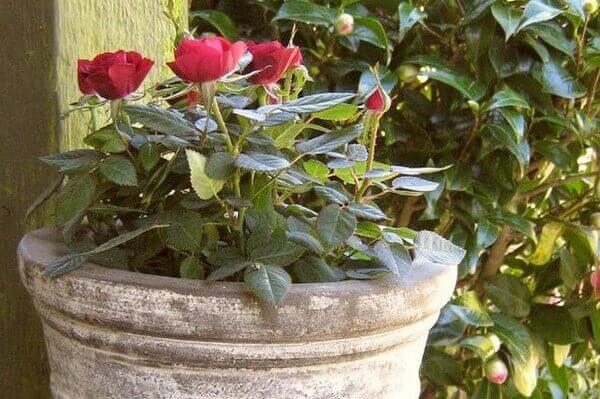

The pot seems big only at first.
The material of the pot can be anything: plastic, wood or ceramics, as long as it does not overheat in the sun. For this reason, for well-lit loggias, it is better to purchase pots and tubs of light shades.
Important! Drainage must be poured into the bottom of the container. Flowers are very hygrophilous, but stagnant water in pots can cause sour soil or root rot. Drainage is prepared in the usual way - from expanded clay, pebbles or rubble. A thin layer of bedding is closed from above with a non-woven membrane that is well permeable to moisture, but retains the soil.
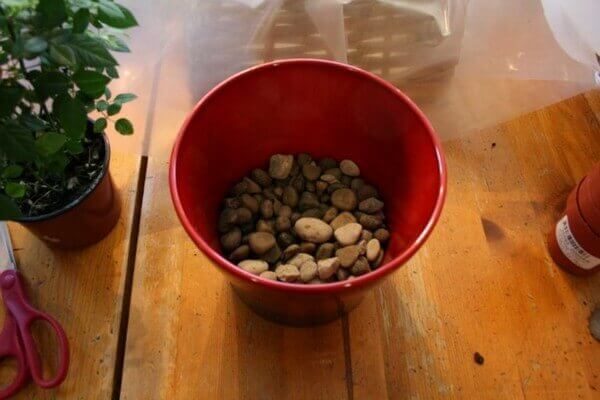

Drainage from small stones and pebbles
The soil for flowers should be loose and nutritious at the same time. Packaged soil from a florist shop is suitable. On the packaging it says: "for roses" or "for tubular flowering plants." You can make the mixture yourself: mix two equal parts of greenhouse humus and sand, slightly diluted with clay. Bird droppings are added as a natural fertilizer. If nettle thickets are found in the country, you can safely take the soil from under the "nippers", it is always of good quality.
How to make a gentle transplant
Often transplantation errors lead to the death of the plant. Flowers are very sensitive to sudden changes in their surroundings. This applies to the slightest changes in temperature, lighting, irrigation regime. Therefore, do not rush to get the flower out of its usual habitat and transplant it into a prepared pot. First, just put the plant in a corner, let it get used to the new microclimate. Abundant watering is not needed; it is better to lightly sprinkle the leaves and soil with water.
It is worth replanting the plant after adaptation, at least in a day. The roots of open-rooted seedlings can be immersed in water and then stimulated with an active substance for better root formation. If the seedling is already planted in the ground, then the native clod of earth does not need to be shaken off, it is recommended to transplant directly with it.
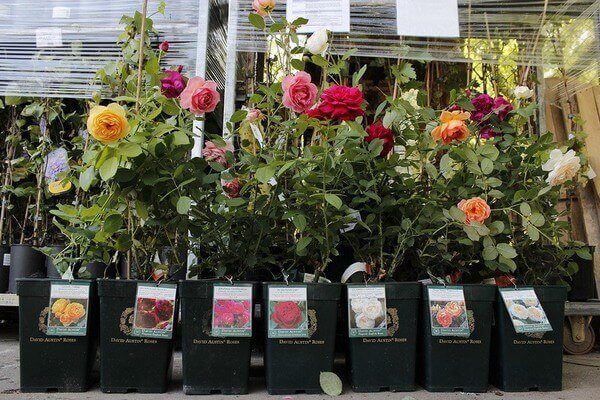

Flowers are ready to move to a new home
After "moving" to a permanent place of residence - in a tub or pot - it is better to hide the plant in a dimly lit corner and water it thoroughly. For the first few days, it should receive doses of sunlight in doses.
Before planting climbing roses on the balcony, they also need to be treated with a stimulant and evenly distributed in narrow long containers that are designed to be attached to the fence. The interval between neighboring plants is at least half a meter.
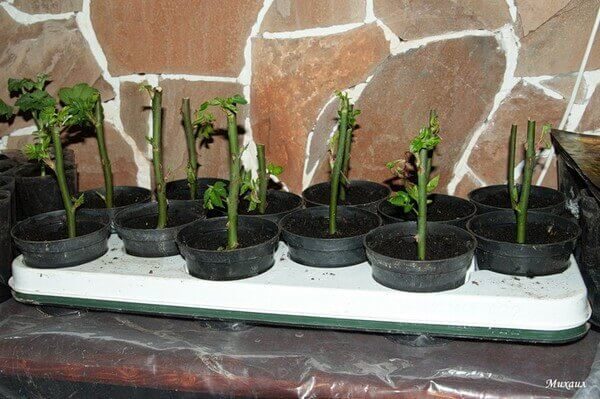

Planting cuttings in pots
After 20-25 days, the first feeding is required. Natural fertilizers or universal solution are dissolved in water for irrigation and added to the soil. From organics, you can choose chicken manure, and from mineral species - complex compositions with potassium sulfate.
Recommendations for the care of the rose garden
During the process of habituation and further development, it is necessary to provide good care for the roses on the balcony or loggia. It includes the following activities:
- regular watering;
- daily ventilation;
- adequate lighting;
- removal of faded buds and dried twigs.
Universal watering regime for the hot season - every other day. If there are few sunny days, then a couple of times a week is enough. In the cold season, one watering a week is enough. To test how much moisture the soil needs, dip your finger into the soil. If the ground is dry at a depth of 5-6 cm, then it's time to water. The liquid should be warm. "Rain" or a stream of water should be directed to the ground, closer to the stem, and in no case to the leaves.


Easier to water with a watering can for indoor flowers
If the doors of the glass structures are constantly ajar, the plants do not need additional ventilation. However, some apartment owners close their windows tightly at night. In the morning, it is imperative to ventilate the room, otherwise the moisture will evaporate worse and there will be a risk of infection with flower pests.
Good lighting and open sun rays are the key to timely and vigorous flowering. However, on the south side, overheating is also possible, from which you need to protect yourself in advance. To do this, it is better to choose volumetric tubs, place plants in partial shade on hot days and ventilate the room more often.
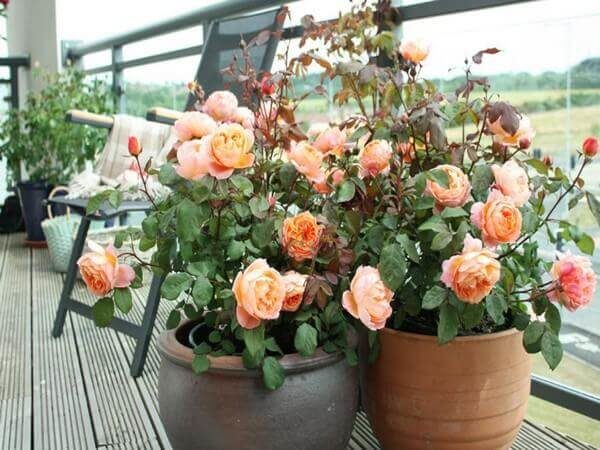

Peach roses on the open balcony
Withered buds are a sign that the flower is starting to seed. This process must be stopped in order to direct the plant's forces to support new inflorescences.Faded buds are carefully cut to the top leaf, and dried branches, leaves and shoots are removed in the same way.
Cultivation and plant care activities
Wintering
Rose is a thermophilic plant. Therefore, the minimum heat temperature in the room should not fall below + 150C. Depending on the variety, the minimum temperature is determined with errors. Be sure to monitor the humidity of the air. For wintering roses, you must choose a place as far as possible from electrical appliances.
When and how to prune a bush rose
The time for cutting a bush rose is late autumn. A well-sharpened knife or pruner is used for trimming. The growth phase of the moon for the owner of a bush rose indoors should become a law - all the key actions for transplanting and caring for a flower are carried out during this period.
Note: If you do not prepare a rose for wintering (do not cut off the bushes), the beauty may not please with the flowering next year. Reproduction of a decorative rose at home.
Spray rose propagation tips
Most home rose combs are propagated by the classic propagation method of a common garden rose - cuttings. Rooting of cuttings is carried out in the spring and summer. This is necessary so that the root system of the rose has time to get stronger.
According to experts, the best way to reproduce a rose is to separate the plant shoot along with the buds. The average size of the cutting should not exceed the 15 cm mark.
As you can see, a bush rose at home is no different from the average indoor flower - what is in care, what is in reproduction, what is in transplantation. The main thing is to choose the right variety for growing. And then the garden beauty will delight her with flowering not only on the site, but also indoors.
Video on how to care for a home rose in a pot:
What varieties of roses are suitable for the balcony
Luxurious shrub growers are constantly experimenting with planting different species. It turns out that, subject to certain conditions and regular care, roses of both soil and indoor varieties grow equally well in pots on the balcony.
Tips for choosing flowering plants
When choosing a particular variety, you must remember the following nuances:
- Balconies and loggias are relatively small in terms of area of \ u200b \ u200bthe room, therefore, preference should be given to medium-sized shrubs. Miniature flowers look more appropriate, besides, it is much easier to care for them than for overgrown lush shrubs with heavy buds.
- It is best to select varieties that look good in outrigger trays, planters, and wall-mounted structures. Climbing roses with small inflorescences - up to 5 cm are suitable for decorating the walls of the loggia or the outer side of the balcony.
- Please note that due to the limited amount of soil, the root system of flowers does not fully develop, so the height of the stems may be less than usual.
- Single hybrid tea plants with large fragrant inflorescences are not suitable for planting in containers for fences or wall compositions. They are planted in large pots and placed on the floor. Low-growing varieties can be placed on a windowsill or on a table.
- Lush blooming floribundas can decorate any room, but these are some of the most capricious species that require constant attention.
- If you have no experience in growing, we recommend starting with ground cover varieties. They are undemanding to the watering regime and less demanding than large bush flowers. Having correctly planted decorative rabatkovye varieties, vertical surfaces (inner walls and the outer side of fences) can be turned into a thick, lushly blooming carpet.
Advice. So that the roses on the open balcony do not freeze in winter, and in the spring they start their flowering cycle safely, we recommend stocking up on varieties that have an ADR certificate.This marking was invented by the Germans in order to isolate the strongest, frost-resistant, disease-resistant lush plants from a huge assortment.
The best varieties according to reviews of experienced florists
Let's go directly to the individual species, which for many years delight lovers of lush bloom and allow you to create magnificent flower gardens on balconies, loggias and terraces.
A tea rose with the romantic name Nostalgie is a popular garden variety that can often be found in summer cottages. However, the lush two-color flowers were so fond of flower growers that they migrated from the ground to home conditions. Nostalgia is distinguished by its endurance, tolerates sharp rises or falls in temperature and reaches 1-1.1 m in height (at home, slightly below normal).
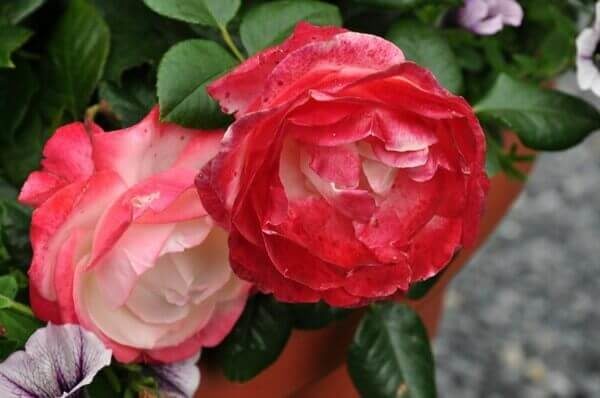

Nostalgia at the time of bloom
Floribunda Rouge Meilove is a delightful member of the rose family. A bright burgundy shade of buds (up to 7-8 cm in diameter), dark green foliage, a neat shape of an adult bush (about 0.6 mx 0.6 m), a delicate aroma - absolutely all qualities are suitable for growing a plant in limited conditions as a natural decor. In addition, the shrub perfectly resists frost and flower diseases, and blooms for 5 months - until the strong autumn cold.
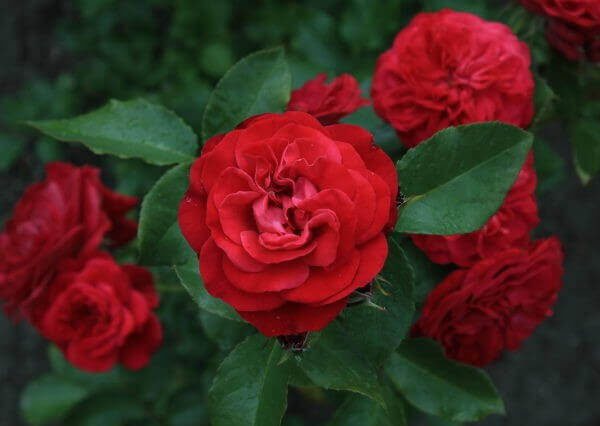

Rouge Meilaw - a bright combination of flowers and leaves
If you prefer snow-white inflorescences, we advise you to pay attention to the tea rose of the Annapurna variety, known for its magical aroma and petals that do not have extraneous shades. In a pot, it reaches 0.5-0.6 m in height, while it blooms profusely and continuously. The buds are large, lush, have up to 20-25 petals. The flower rarely gets sick and perfectly tolerates short-term frosts.
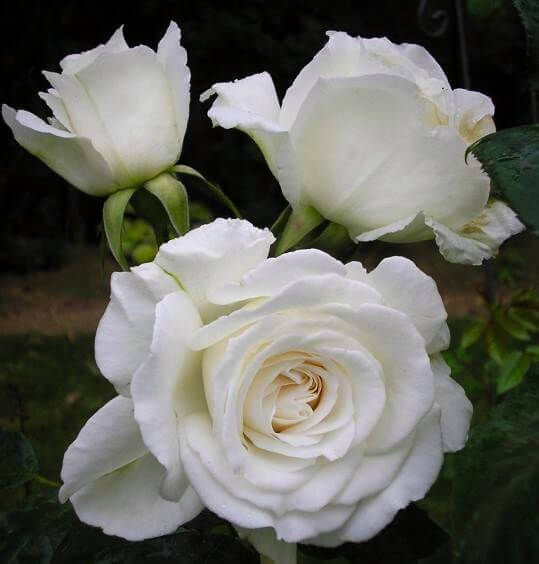

The boiling white color of Annapurna petals is difficult to confuse with other shades.
Among the bush species, Heidetraum stands out for its delicate shade and vigorous flowering. A short shrub (about 0.5-0.6 m in height) grows well to the sides, so it is better to prepare a wide pot or container for it. The plant has an amazing feature - the petals on old inflorescences do not fall off, but turn pale, becoming pale pink and light lilac. Thanks to this, the shrub has an attractive blooming appearance until mid-autumn.
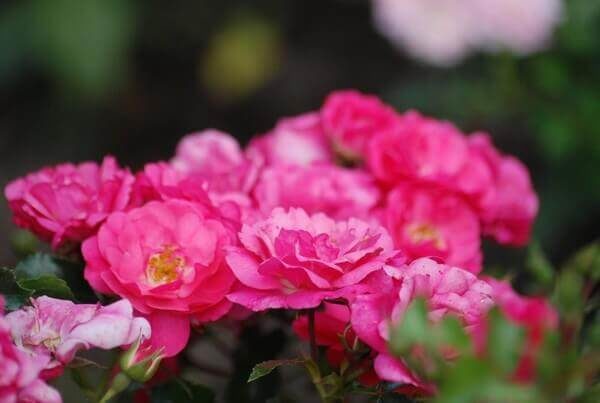

Lush bloom of Heidetraum
In addition to the listed representatives of the Rosaceae family, we recommend trying the following varieties of garden roses in pots or containers on the balcony: Sonnenroeschen, Rotfassade, Apricot Meilove, Bambino, Gateway, Leona, Innocencia, Loredo, Gartnerfreude, Rosika.
Shrub roses: types, planting, care during cultivation
Shrub roses are very beautiful and today there are two types with many varieties.
Types of spray roses:
- Old park;
- Flowerbed roses.
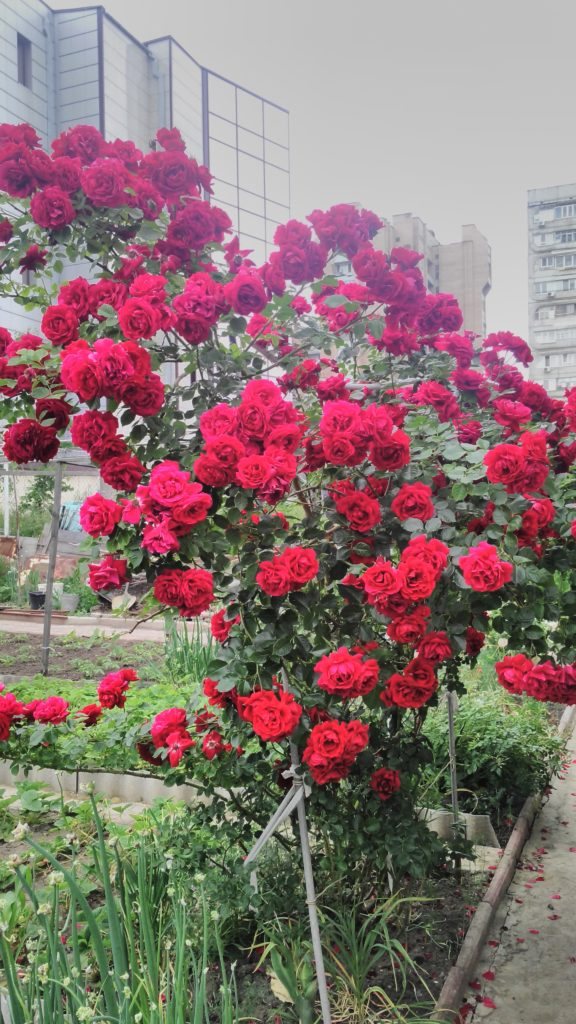

my mom's roses
Old park roses include varieties such as:
- White Rose
- French
- Damascus
- Stolistnaya
- Portland
- Eglantheria
- Scottish
- Wrinkled
- Tea room
- Bourbon
- And some varieties of remontant roses
To bed roses are varieties such as:
- Tea-hybrid
- Polyanthus
- Floribunda
- Roses - patio
- Grandiflora
- English roses.
Undoubtedly, each variety of park bush roses has its own unique characteristics, but most of them are highly branched shrubs with many foliage, up to 1.5 meters high. Most of the listed varieties bloom only once in the middle of summer. The flowers are cupped, collected in small inflorescences with a traditional color.
As for flower bed roses, this type is more common, representatives of which can be found in almost every area. It is mainly flower bed roses that are on sale, which are small shrubs from 50 cm to 1.5 m.Most gardeners choose these roses because of the long flowering, since this species begins to bloom at the end of June and flowering continues until late autumn. But they do not bloom all the time, but in waves. There are varieties that can be grown indoors.
The choice of soil and pot for planting
It is best to purchase a room rose already rooted. This is especially true for novice amateur flower growers. Such a plant has already managed to get strong enough and adapt to the environment, while you will have to tinker with the cuttings. At the same time, there is no guarantee that they will survive. Especially if a beginner amateur florist is getting down to business.
The main rule in growing this plant is the correct choice of soil and pot. It is recommended to transplant the plant into a permanent pot from a shipping pot no earlier than two weeks after purchase. Otherwise, the rose will not have time to properly adapt to new conditions and will receive additional stress. So the flower can get sick and die.
Roses must be transplanted carefully, without destroying the earth's clod and not disturbing the roots.
It is best to replant the rose not in the spring, but in the fall. It is at this time that the plant endures all sorts of stresses best of all. A pot for a bush indoor rose needs to be selected a little larger than the one in which it was previously. Very roomy dishes can shorten the flowering period. At the same time, the earth, which has not yet had time to be entwined with roots, may turn sour. From this, the root system of the flower will begin to rot.
Now for the choice of soil. Indoor rose is very fond of sand and peat, so it is important to add these ingredients to the growing substrate. The soil is considered optimal for a rose, which contains about 15% of sand, 25% of humus and peat, and about 20% of black soil. Before planting the plant, the soil should be thoroughly mixed and slightly moistened with a spray bottle with warm water.
Since this plant does not tolerate stagnant water in a pot, you need to immediately take care of good drainage. Pebbles of expanded clay should be poured onto the bottom of the container, on top of which sphagnum moss should be laid with a thin layer, which will protect the roots from decay. But before pouring the main soil into the pot, you need to pour another thin layer of sand on top of the moss. Then plant the plant in the usual way.
It is recommended to sprinkle sand over the top of the pot with sand from time to time. It should also be borne in mind that indoor rose does not tolerate an alkaline environment. Therefore, if possible, you need to acidify the soil. Otherwise, the plant may die.
Shrub roses - planting, care and cultivation
Planting spray roses
Planting bush roses begins with choosing a location, so choose a place with plenty of light in the morning. If you plant your rose in the shade, then its shoots will stretch out and it will bloom poorly (or not at all).
Also, make sure that the place is sheltered from the winds. You can plant roses by the fence, or the walls of the house, but it is important that there is no shade.


It is better to plant roses out of the blue, or on an elevated place. Never plant roses in a low area where water can accumulate.
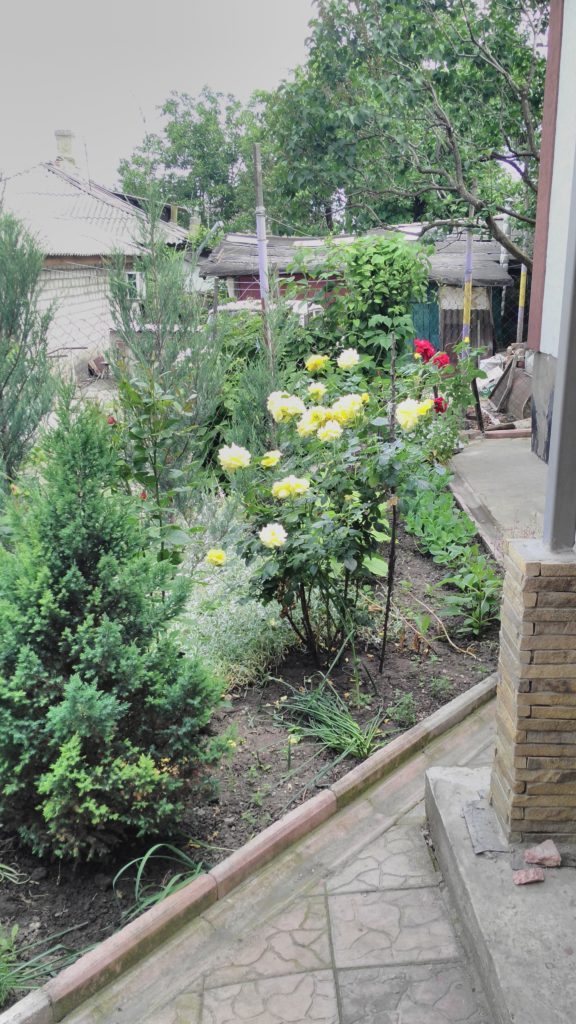

my mommy's roses
Soil requirement
Ideally, the soil for roses should be nutritious, loose, breathable and slightly acidic. But, unfortunately, it is difficult to find the perfect soil for planting spray roses. But you can improve the soil that you have.
It is better to prepare the site for planting in the fall, or 3 months before planting. First, they dig a hole, 30-60 cm deep, and fill it with a nutrient mixture, which is prepared from garden soil, compost (leaf humus, rotted manure, etc.), mineral fertilizers (20 grams of potassium chloride are added per 1 m2, 30 gram of ammonium nitrate, 70 grams of superphosphate).
How to plant bush roses in the ground
Bush roses
So, before planting spray roses, you need to prepare a planting mixture, which is prepared from 1 part of garden soil, 1 part of peat and add 3 handfuls of bone meal. 2 handfuls of the mixture are poured into the bottom of the pit in the form of a tubercle and the roots of a bush rose are lowered there, evenly distributing them along the slopes of the slide.
Important! Make sure that the roots of the rose do not bend upward. All roots should be directed down to the bottom of the hole.
It is also important to ensure that the vaccination site is 2-5 cm below ground level.
When the roots of the rose are spread over the bottom of the pit, you can sprinkle them with the remaining prepared planting mixture. And so that the mixture is evenly distributed between the roots, the seedling is gently shaken up and down. This must be done in the same way so that air pockets do not form between the roots. Further, the mixture is compacted with your hands and the remaining place is covered with garden soil and the planting site is trampled underfoot.
A few shared secrets
- When growing a rose in winter, when there is a lack of natural light, it is worth organizing artificial lighting, and fluorescent lamps are best suited for this. If there is not enough light in greenhouses, it is better to use sodium varieties with a power not exceeding 650W.
- It is better to replant roses closer to autumn, so that it has time to take root by winter, or in spring, so that it can take root by summer.
It is best to replant roses in the fall. - You need to closely monitor the appearance of plants and, at the slightest appearance of spots and darkening, figure out what is the reason and take action. In the early stages, any shoot diseases can be cured.
- If you use a jar as a greenhouse, it should be lifted periodically and the seedlings should be allowed to “breathe”.
- When transplanting rooted stems from greenhouse conditions into pots, this should be done gradually, increasing the time they stay without a greenhouse. It is not recommended to immediately remove the jar or polyethylene, this is stress for the rose.
- As a greenhouse, you can use not only polyethylene or cans, cut plastic bottles are great.
- For domestic roses, do not save and take land from parks, vegetable gardens, etc. It is better to buy a special one in a store, it is lighter in structure, has the necessary nutrients and does not contain pathogens.
Beautiful rose "Princess Alexandra of Kent"
Currently, there are a lot of varieties of roses, which allows everyone to find an option to their liking.
Understanding how to grow a rose from a cut flower or seed is a simple matter, the main thing is to follow the instructions clearly. It is much more important to properly care for it for months during the growth process, preventing temperature extremes and drying out of the soil. Also, gardeners recommend additionally regularly spray the cuttings from above. With strict observance of all the necessary conditions and recommendations, after a long period of continuous care for a fragile plant, a beautiful rose will reveal itself to the world and its owners. Under careful care, a home rose is able to satisfy aesthetic needs, bring freshness and give a feeling of coziness for many years out of seasons.
What could be more beautiful than a fresh blossoming pink bud, yes, and not somewhere on a flower bed or lawn, but on your windowsill? To breed a real rose garden in your apartment, perhaps you just need to know how to properly care for a whimsical plant so that it delights you with its flowering longer.
Shrub roses - care and cultivation
Watering spray roses
Mature plants have a long root system, therefore, such seedlings do not need frequent watering. Such roses are rarely watered, but abundantly, but frequent, but not abundant watering is very harmful for bush roses.
The lack of moisture negatively affects the roses and affects this primarily on flowering. Due to the lack of moisture in bush roses, flowering decreases, the flowers are small, or deformed, or there is no flowering at all.
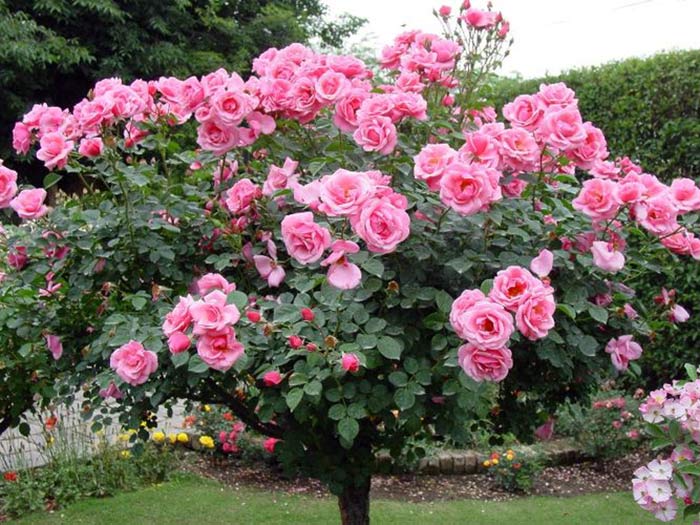

Bush roses
Therefore, on hot summer days, roses are watered every week, and newly planted roses are watered more frequently until they take root.
Do not water roses with cold water, especially in the heat.
Water for irrigation is defended in advance so that chlorine evaporates from it.
Bush roses
Some gardeners recommend watering bush roses with rainwater, but it seems unsafe to me. Nowadays, a rain cloud can fly from an unfavorable area and when watering with such water, you can harm the plant. Rainwater must be cleaned before irrigation, and this is difficult to do under normal conditions.
Do not water roses with water taken from swamps and other open bodies of water. Such water contains many pathogenic bacteria and microorganisms.
Loosening the soil
Thanks to such a simple procedure, the soil easily passes air and water to the roots, due to which the root system and ground shoots develop normally.
The soil around young plants is loosened regularly once a month. And in adult plants, the soil is loosened in the following cases:
- After heavy watering, or rain;
- In early spring, when the soil has thawed;
- After fertilizing;
- After pruning and removing inflorescences;
- Before you cover your roses for the winter.
The soil around the bush is loosened no more than 3-6 cm to a depth so as not to damage the root system.
Also, caring for roses is to regularly remove weeds.
After the plant was watered, the soil was loosened, weeds were removed, a layer of mulch 4 - 8 cm thick was placed around the plant.
moj-
Winter protection requirements
For the winter, roses plunge into a state of dormancy, do not bloom, accumulate strength for a spring breakthrough. If you bring them into the house and allow them to develop as usual, they will throw off the leaves and quietly wither away. Therefore, it is better not to argue with nature and think about how best to cover the roses for the winter on the balcony, in their usual environment. For pots or containers, a corner, a large wooden box, or a spot near a “warm” wall should be set aside.
There is no need to argue about the temperature at which roses should be stored on the balcony. It is believed that with good insulation, the flower easily tolerates cold temperatures down to -10 ° C, however, more attentive flower growers manage to preserve the plants in more severe conditions.
The most important condition for wintering roses on the balcony is a warm "cocoon" that covers the pot with the plant from all sides. For multilayer protection, use thick plastic wrap, old quilted jackets and jackets, wadded blankets and bags, spruce branches and jute rugs. Some craftsmen use all kinds of building membranes that create high-quality insulation.
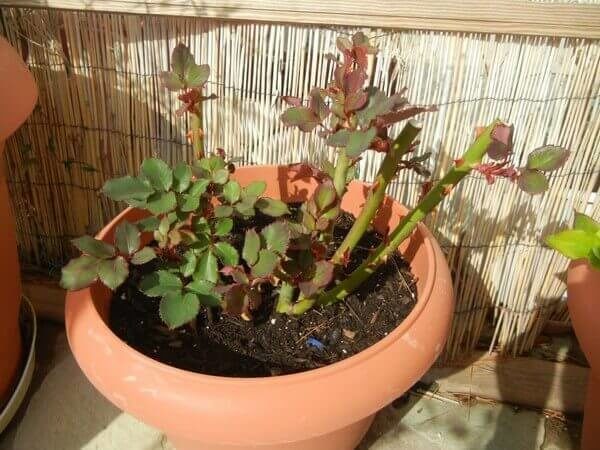

Spring preparation of the plant
However, do not forget that the plant, even in a dormant state, requires care and at least occasionally needs to be watered. Closer to spring, you can renew the soil and treat the bush from pests.
Features of spray roses
Shrub roses belong to the genus of rose hips and look like a large spreading bush up to two meters high. Looks great both as a part of compositions with the participation of other plants, and as a single "decoration" of the site. Rose bushes are also quite often planted as a hedge, hiding their area from prying eyes with luxurious flowers.
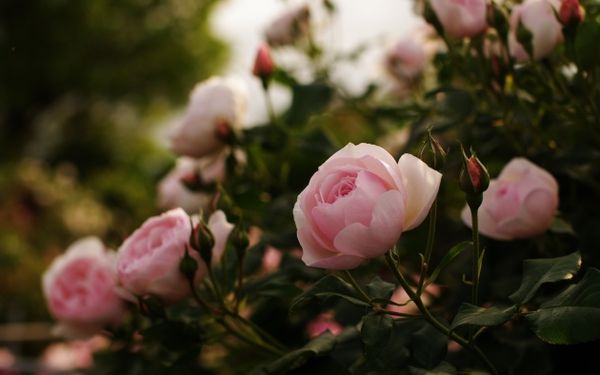

Shrub roses come in many varieties, both large and small. The main varieties of roses planted on the bush include:
- "Burghausen" - plants of this variety grow up to two meters and bloom profusely;
- "Abraham Derby" - English rose;
- "Red Cascade" - blooms with very small bright red roses;
- "Iceberg" - a beautiful white rose;
- "Hi-ho" is a weaving variety, the flowers of which can be red and lilac.
Of course, you can choose a rose of a different variety, but it is worth approaching the choice wisely, since the external characteristics of the plant will depend on the selected variety.So, the plant can be spreading or narrow pyramidal, and the shrub can be from half a meter to several meters in height, and this should be taken into account, correlating with the characteristics of the site.
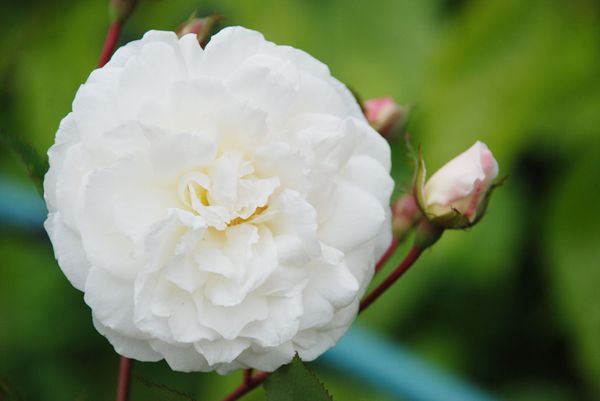

The leaves of these plants are predominantly oval and slightly serrated at the edges. The buds can be of completely different sizes (it directly depends on the selected variety) - from babies to real giants. Shades, inflorescences, flower shape - all this changes depending on its variety. The main feature of this plant is that its life form is a shrub. Planting and caring for a shrub is not too difficult, so every grower can afford this luxury.
Classification - varieties and species
The need for a garden classification system is due to the development of the science of selection. Acquaintance with the classifier allows breeders to continue their work on breeding new varieties of the "queen of flowers", and amateur flower growers, to properly care for their very capricious green pets. Without going too far into the abyss of breeding science, all currently existing species can be conditionally divided into several groups and classes, depending on the presence of stable garden traits.
The first version of the classifier was created and approved by the American Rose Society in 1976. In 2000, in a slightly modified and supplemented form, the classifier was published in Modern Roses. In accordance with this version, all roses can be divided into the following types: old, wild and modern garden roses, with subsequent gradation into certain groups depending on the color and number of petals.
Planting a bush
Planting spray roses in the garden is a procedure that is not particularly difficult. To begin with, you should choose the right place: the shrub must have access to sunlight and be well protected from the cold wind. A high level of groundwater will also not be to your beauty's taste - choose a place on the hills or remove groundwater using additional procedures.
Before planting, prepare the soil and pay attention to the fact that the plant prefers slightly acidic soil, where moisture does not accumulate and oxygen passes well. Dig a hole, which should exceed the length of the root by 10 cm. Then the soil is mixed with fertilizers (1/3 of the compost and a glass of charcoal).
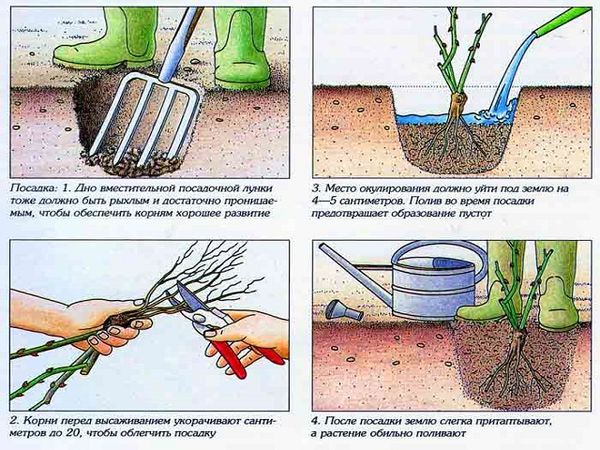

Before proceeding with the procedure, use sterile garden shears (or a knife) to slightly shorten the roots of the seedlings, if there are sick or broken ones, remove them without regret. The stems are also cut off (only cuttings remain) and soaked in warm, settled water. After that, the seedling can be placed in the ground, carefully spreading the roots for it, and then tamping it down with earth. The root nodule should be at ground level and the seedling should be upright. Build an earthen roller around the cutting to hold water, and the soil around the stem bends ten centimeters.
Reproduction of rose bushes at home
Landing can be done in several ways:
- using seeds;
- by vaccination method;
- by cuttings.
The most optimal and effective method of the above is to grow roses from cuttings. In order for the reproduction procedure to be successful for the cutting, you need to choose a stem with a formed bud.
Such samples are the most persistent, since they contain the maximum possible amount of nutrients necessary for the development of the plant's root system. Undoubtedly, there are cases when it was possible to grow a rose bush from a flower included in an ordinary store bouquet, but such precedents are very rare.
So, when choosing a stalk for planting, you need to pay attention to its length, its optimal indicator is about 30 cm.Further, you need to make an incision at a minimum angle of inclination, remove the bud and leaves with a sharp knife.
After performing these manipulations, the cutting should be left in a container of water for 10-15 minutes. Next, you need to process the sections (lower and upper) with potassium permanganate. Before planting the cuttings in the ground, the preparation process of which is described in detail above, it must be kept for 24 hours in a weak solution of heteroauxin. To prepare the solution, it is recommended to adhere to the following proportions: 1 tablet per 1 liter of settled water. Heteroauxin can be replaced with potassium permanganate.
It is recommended to plant the cutting in well-loosened soil, it is important to make sure that the bud (the second node of the cutting) is above the soil.
After planting the cuttings, you need to create a greenhouse. You can use plastic wrap or a cut plastic bottle for this purpose. Watering, spraying should be carried out daily, but in such a way that the root system does not rot.
After some time, when the first leaves appear on the handle, the greenhouse can be removed. To strengthen the root system, flower growers recommend cutting the buds in the first year after the growing season.
Flower care
Shrub roses require special care, and in order for them to grow well and are pleasing to the eye, you need to follow a few simple rules. First, provide the shrub with proper watering. While mature specimens are watered as soon as the topsoil is dry again, provide young bushes with abundant watering three times a week. Secondly, get rid of weeds around the shrub, as they can destroy its root system.
Do not forget about dressing - in the spring it is better to feed bush roses with nitrogen-containing fertilizers, but in the fall you need to add potassium-phosphorus dressings.
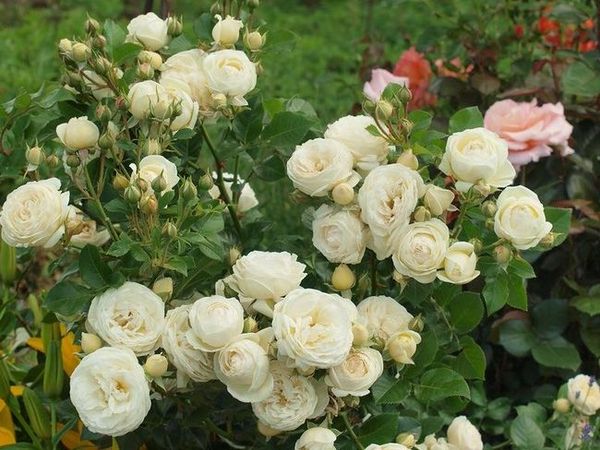

Shrub roses can even be grown in a pot, and caring for a potted rose at home is not too different from caring for a plant in the ground. It also needs to be watered often (in the heat - twice a day), fertilized (for this they use mullein and foliar feeding) and remove dead particles. However, in general, a room rose is a very moody plant, so if you decide to start it, carefully study its features.
What to do with a flower after purchase?
The shops offer a wide range of roses. Flowers for sale in containers. Often, some time after purchase, the plant begins to wither, dry out and die, and the leaves turn yellow and fall off.
To prevent this from happening, you should perform the following actions:
- Examine the flower (assess its condition, the presence of parasites). All dry and blackened branches, leaves, wilted buds must be removed.
- Carry out treatment with Fitoverm to protect against pests.
- Spray with a disease-fighting fungicide solution.
- Prune, leaving 5 buds on each shoot.
- If the soil in the pot is wet, the rose must be removed along with the lump, put on a cloth or paper. When excess moisture is absorbed into the material, plant the flower back in the pot.
- Place container in a cool, shady, draft-free area.
After that, it is important that the plant adapts to the new conditions. To do this, it is recommended not to touch it for several days. And then they start the transplant. How to properly dilute and root a flower with a handle in the country?
How to transplant a rose?
For a transplant, you will need a fertile substrate, small stones or sand, drainage material, vermiculite, a flowerpot and stimulants for adaptation.
Some experts advise rinsing the root zone, removing all soil, and then soaking it in a stimulating solution. Others argue that such a procedure is not necessary and that it is enough just to sprinkle the flower and leaves with special compounds.
It is better to buy the substrate and soil in the store. But if this is not possible, you can prepare the soil mixture yourself. To do this, take sod, humus soil and coarse sand in a ratio of 1: 1: 0.5.To protect against diseases, it is recommended to add phytosporin in powder form to the soil.
Drainage is placed at the bottom of the pot. Above is a layer of substrate. They put a plant and sprinkle it with earth. To create greenhouse conditions, the flower is covered with a plastic bag or jar. Under such a shelter, a home garden rose should stay for 10 days. At the same time, it is recommended to ventilate every day by removing the can or bag for a while.
The flower needs to be treated with stimulants weekly. In the future, a transplant at home is carried out every year. As the plant grows in size, it is better to choose containers 2-3 centimeters larger in diameter than previous pots.
What conditions of detention are required?
Since the domestic Chinese rose is not a tropical plant, it needs moderate conditions. In summer, the temperature in the room should be low (from +20 to +25 degrees), and in winter you can keep it cool (+ 10-15 degrees). Overheating and low humidity have a detrimental effect on the Chinese rose.
Experts recommend placing hibiscus pots in an apartment on the western or southeastern windows. The plant is light-loving, but it must be protected from direct sunlight. In the summer, it is better to take the flowerpot with a large Chinese rose to the terrace or balcony. The soil should be used moisture and air permeable. Drainage holes should be made in the pot.
Disease and pest control
Caring for a bush rose also involves treating pests and diseases that can infect the bush. The most common are fungal diseases (powdery mildew, rust, black spot), which can be eliminated with fungicides (copper sulfate and colloidal sulfur). If the flower strikes chlorosis, from which the plant rapidly turns yellow and withers, then the matter is in the lack of nutrients. It is necessary to analyze the soil, identify what is missing, and fill the gap by making the necessary additives.
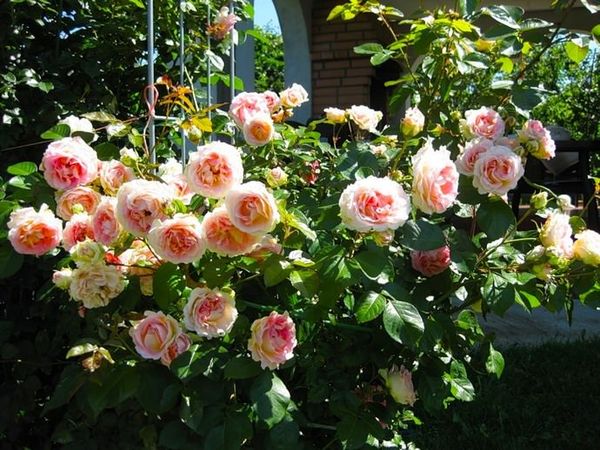

Pests are divided into sucking, which infect the aerial part of the plant, and gnawing, which harm the root system. Usually, in order to prevent such "attempts" on your beauty, carry out the spring treatment with karbofos or rogor, or spray the plant with a solution of kerosene (2 g per 10 l of water). You also need to remove the fallen leaves and cultivate the soil (using the same preparations) so that the pests do not stay overwintering under your flowers.
Reproduction of indoor roses
Figure 1. The scheme of propagation of indoor roses by cuttings.
It will be quite difficult for a beginner to propagate roses at home. There are several ways, but it is best to try cutting the plant. At the same time, the survival rate of cuttings is the highest in comparison with other methods of reproduction. It is imperative to choose the right stalk.
It is best to cut a stalk about 30 cm long from a branch that already has a formed bud. In this case, the cuts must be made at minimum angles on both sides. Excess leaves and flowers should also be carefully removed (Fig. 1).
Next, both edges of the cutting must be wrapped with wet gauze - let the twig lie like this for 10-15 minutes. Then treat the cut sites with potassium permanganate solution. Do not forget to process the cut site on the mother plant. The stalk with the side that is planned to be planted in the ground must be kept in a root solution for a day (1 tablet of the substance per 1 liter of warm water).
Now you can plant the cutting in sand or light soil. It should be deepened into the substrate so that the nearest bud is above the ground. The plant needs to be watered and sprayed daily. In this case, be sure to cover the rose with a bottle, in which to make a small hole for air. This will create a greenhouse effect. But when the stalk gets stronger, starting to release new leaves, it will be possible to remove the bottle.
So, if you follow all the above tips, you can learn to take care of even such a capricious plant as indoor roses without much effort, enjoying the flowering of the bush in the house all year round.
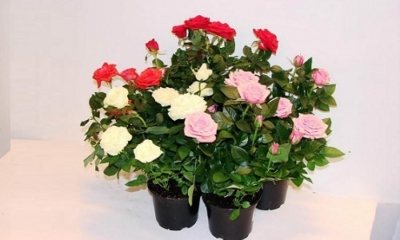

Shrub roses are very popular among flower growers. They are compact in size and fit perfectly into any interior.
And their beautiful bloom pleases the eye for a long time. They are capricious in their care, so they need special conditions of detention.
This article describes in detail the process of growing a bush rose in a pot. It also provides helpful tips for growing the plant.
What you need to know before starting growing
Many people believe that caring for roses at home is just watering, but this is not the case. For flowering, the rose needs to create the most comfortable conditions.
You need to create the most comfortable conditions
Often, plants that are in a state of flowering are bought in flower shops, so it is important for them to ensure the correct adaptation period. So that all efforts are not in vain, you need to create peace and freedom for the plant in the first days. In no case should you immediately transplant roses brought from the store, as they need to get used to the indoor microclimate.
You need to pay attention to the conditions in which the plant was previously and try to accurately recreate them at home. To do this, you just need to consult with the seller. It is imperative to clarify information regarding:
- combinations of shadow and light;
- temperature;
- humidity;
- watering regime.
The addiction can last for 2 weeks, which is why during this period it is necessary to protect the plant from weeds, and also prevent overheating in the sun.
Important! It is better to replant a rose during the growth phase of the moon - this will increase the chances of growing a healthy and strong plant.
It is imperative to purchase special fertilizers for roses, which are available in almost every gardening store. It is important to immediately prepare the soil for the subsequent plant transplant. You can purchase a ready-made substrate, but you should strictly monitor its quality.
It is important to know how to properly grow roses at home. Flowers should not be allowed to dry out, so timely and abundant watering must be ensured. Withered leaves and flowers must be removed immediately with a secateurs. In this case, they will bloom much longer, and more inflorescences will appear.
It is important to prepare the ground right away.
When growing roses, you need to ensure that diseases and pests do not appear on them, so you should periodically inspect the leaves, stems and flowers. Observing all the simple rules, you can grow a beautiful flower that will delight you with its excellent flowering for a long time.
What should be a greenhouse for growing roses
Before getting cuttings, you need to prepare your greenhouse. The land in it must be enriched. Rotted manure, superphosphate or peat mixture is introduced into the soil. The nutrient mixture can be prepared as follows: mix 4 parts of peat with 1 part of cow fertilizer and 4 parts of turf. All this is mixed and left for a year in the upper layer of the earth. Then bone meal is added there. The proportion is indicated 1 kg for 1 sq. M. land.
The height of the greenhouse should be at least 3.5 m. This is exactly how much air is needed by volume for one meter of planting.
In the greenhouse, it is necessary to install equipment such as:
- additional lighting lamps;
- soil heating device;
- fan;
- thermometer;
- shading devices;
- moisturizing system.
You should also consider the design of the greenhouse for growing roses. There should be air vents along its perimeter.
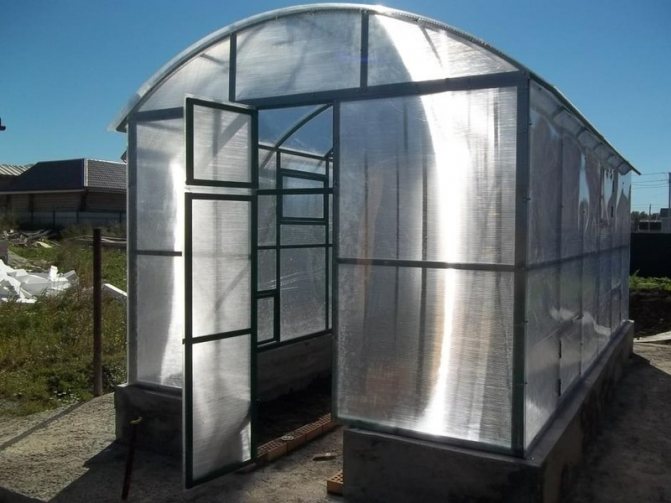

Small greenhouse for roses
What is this houseplant?
Botanical description
In a room rose, the stems are thick with thorns, the leaves are dark green, tough. The flowers of the plant are small and of different shades.
Features of the
The main feature of a rose when grown at home is that it does not grow more than 50 cm in height. It is propagated only by cuttings, a grafted plant, most often does not survive indoors.
Pros and cons
pros:
- Year-round flowering.
- Compact size.
- Can be planted on a garden plot.
Cons of the plant:
- Difficulty in leaving. The plant is capricious and requires increased attention. If not properly maintained, it can get sick.
- Rest period. In winter, the rose requires special conditions.
- Weak aroma.
Many of us have fond memories of outdoor plants. How often we, walking in a park or garden with our beloved, breathed in the delightful scent of asters, tulips, and other equally beautiful plants. As we admire the variety of sophisticated flowers, we would like these wonderful plants to stay with us indoors. Being in a romantic mood, we pick flowers and take them home, hoping to tame them to breathe in the amazing scent of violets at night or admire the fragile snowdrops ... But the inhabitants of the gardens do not want to live in seemingly ideal conditions at home and wither without saying goodbye. From this we usually conclude that street plants cannot be domesticated and continue to sigh, looking out of the window into the garden, in which gladioli, irises and other beautiful fairies of the plant kingdom sway in the wind.
In fact, the definitions of "houseplants" are just words. Initially, all plants lived on the street, however, in different climatic conditions. Therefore, "indoor plants" are flowers that have adapted to the conditions of our homes. Therefore, in order to contemplate any beautiful plant in your room, you just need to help it get used to it. Such popular and demanded flowers as roses have been available for a long time in small and large pots, but, as practice shows, street roses are more popular. The ones that are presented in chic bouquets. The process of domestication is somewhat more complicated than other flowers, since roses are a very wayward and proud flower. There is even an opinion that this plant will take root only in a girl with the character of a "rose" - beautiful and a little cold, with a twist, sharp as thorns.
Rose varieties that can be grown without much hassle at home
Not so long ago, we had access only to Chinese roses, but now we have all kinds of varieties at our horticultural disposal:
· Ground cover roses - are considered the most suitable and suitable for keeping at home. Among their advantages are a long flowering period (almost six months), a strong aroma, a variety of flowers (double, simple, semi-double);
· Hybrid tea roses are distinguished by a huge selection of subspecies. If you have a greenhouse or are willing to set aside a large space for a rose garden, this variety is perfect for you. They reach one meter in height and are often dotted with beautiful flowers.
· Flowerbed roses and polyanthus are suitable for keeping in tubs, which can be taken out into the garden in the warm season. To communicate with street brothers, so to speak.
Difficulties faced by gardeners
Before you move the plant into the room, decide where you will keep it. A miniature tulip will fit perfectly on the windowsill in your bedroom, but there won't be enough space for roses. In order not to give up space for flowers on your bed, and not to move to the windowsill yourself, arrange a place for a rose garden in advance. Then carefully examine the plant, it may be infested with parasites. In this case, leave it in the garden until it heals completely, as there is a danger of contamination of indoor plants. Garden roses are especially susceptible to attack by spider mites. Moreover, he can overtake your plant even in the house. Next, take care of sufficient air humidification, there is always not enough oxygen in the apartment, and it is too dry.Fortunately, this problem can be easily solved by spraying and watering.
The nuances of growing indoor rose garden
For transplanted plants, the best soil will be regular garden soil mixed with rotted compost (2 to 1 ratio). Sand and charcoal can also be added to such soil. But even the finest soil does not guarantee a successful rose domestication if you place it in the wrong container. The pot should not be as wide as deep. This is due to the taproot system of the plant. It is also worth paying attention to the material of the tub. In plastic and clay pots, the soil dries out faster, and along with dry room air, this can significantly harm your rose. A wooden or ceramic container is the right choice. Expanded clay or the most common small stones are suitable as drainage. An important point is feeding the roses. Unlike other flowers, this plant does not like excessive and early fertilization, therefore, nutrients can be applied only after the first flowering. In winter, your sensitive rose beauties can freeze. The water always cools faster, and even if the room is still warm, the rose may already freeze. The way out can be external insulation of the rose. Some put the plant under an air conditioner with warm air, but this is destructive, since the hot air flow dries up the soil and air even more.
The right time
Roses can be cut at any time of the year. Florists often root cuttings cut in the summer. But autumn is considered the most successful season for propagation by cuttings: cuttings cut from rose bushes during autumn pruning are planted in the ground for rooting (read about cutting and rooting roses in autumn here?).
But there are situations when such copies fall into the hands of a lover of these flowers, the acquisition of which he has long dreamed of. And it is already winter outside, and there can be no question of full-fledged rooting of the plant. Therefore, it makes sense to save the harvested shoots until spring.
Breeding features
Roses at home are propagated by cuttings. The best time for grafting is from May to September.
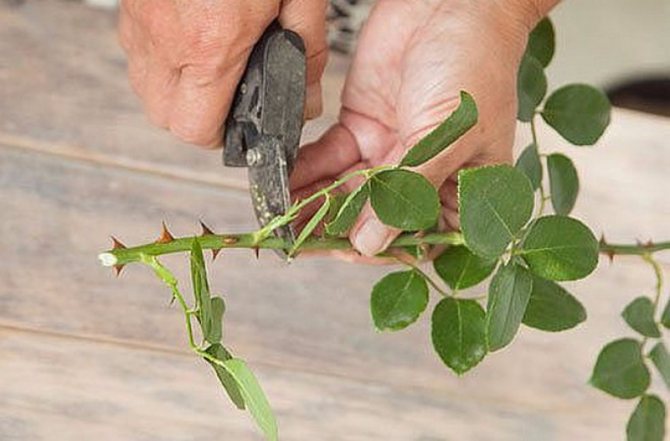

Cut off almost lignified cuttings (about 10-15 cm long) from the faded shoot with a secateurs. Place the cuttings in clean, warm water. On the body of the cutting should be present about 3-5 buds and a few leaves. The first roots appear after three weeks. Plant well-developed cuttings in a prepared fertile substrate. For planting young plants, use small containers (about 200-300 ml).
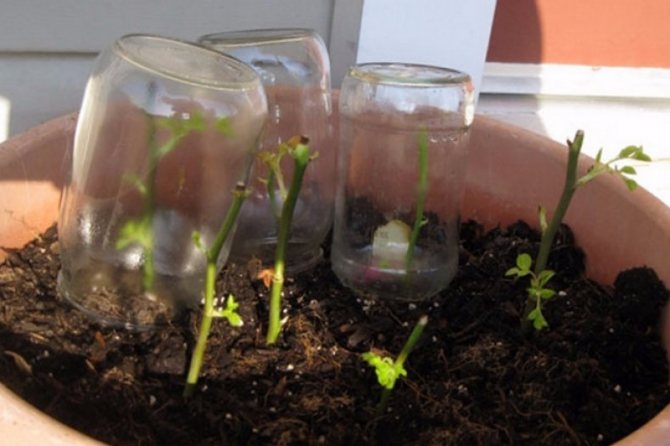

For successful rooting of cuttings, add Heteroauxin growth stimulant to the soil. It is advisable to remove the first buds. If the planting process was completed before hibernation, rapid growth and flowering is possible already next year.
Preparing for planting sites and planting material
When growing a rose in an apartment, you need to take into account that the flower is quite picky about the planting site. The place for the flower pot should be well warmed up and be sufficiently lit. In the shade, the growth of the rose slows down somewhat, the shoots stretch out, the buds grow small.
Do not allow waterlogging, as this contributes to the defeat of fungi and other diseases. It is very important to properly prepare the soil or purchase a ready-made substrate at a flower shop.
The flower is quite picky about the planting site
For your information: for planting a rose, black soil and light loam are ideal.
The day before planting, the roses should be placed in water for about 10 hours. Before planting, the roots must be shortened to 20 cm, and the damaged ones must be cut to healthy tissue. After that, remove all dried branches, and trim the remaining ones a little. In strong shoots, 5 buds are left.
Temperature and lighting
The temperature regime for a room rose should be as close to natural conditions as possible.In summer, it can suffer from excessive heat, overheating and drying out of the soil, and in winter from drafts and cold. The optimum temperature during the flowering period is considered to be 22-25 ° C and this degree should be maintained at home.
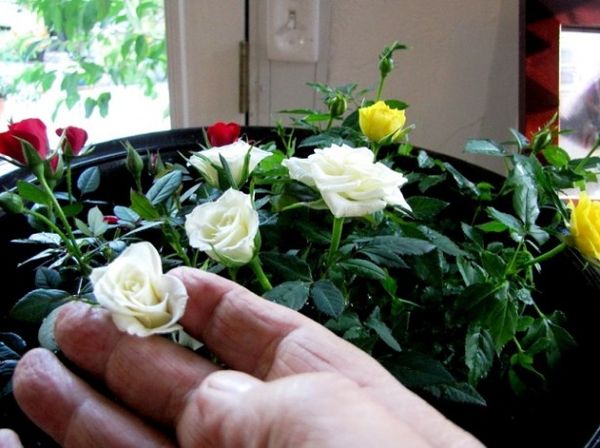

Do not place the rose next to indoor heat sources (batteries, heaters). For a dormant period, it is advisable to lower the temperature to 10-15 ° C, and if possible, move the plant to a cool place. Also, in winter, the flower may need additional lighting.
Planting a rose in a permanent place
A cut rose can be used to grow a beautiful bush that needs a permanent location. We already know how to grow roses from cuttings, now we will deal with the further growth of a new plant.
In order for the transplantation of rooted material into open ground conditions to be successful, it is worth considering this matter as carefully as possible.
ATTENTION! (click to find out)
ATTENTION! A freshly transplanted rose requires regular soil moisture, which should not be confused with watering! Excess moisture will lead to rotting of the plant.
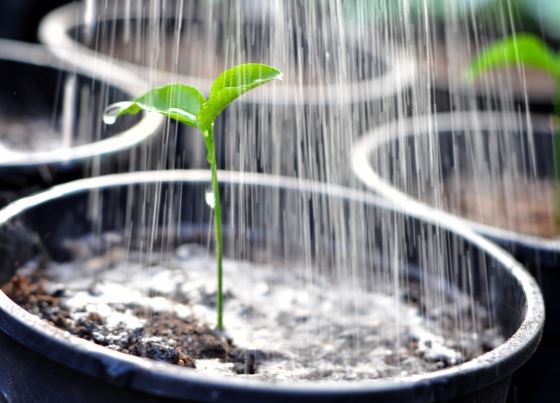

Prepare the soil in advance: light and nutritious soil is diluted with river sand or vermiculite. Mineral and organic fertilizers in the form of humus, poured in advance and mixed with the ground, will allow your bush to become a real queen of the garden.
Top dressing in the first year is carried out in 4 doses. You cannot immediately add fresh bird droppings or manure, such substances must be diluted with water in a ratio of 1 to 10.
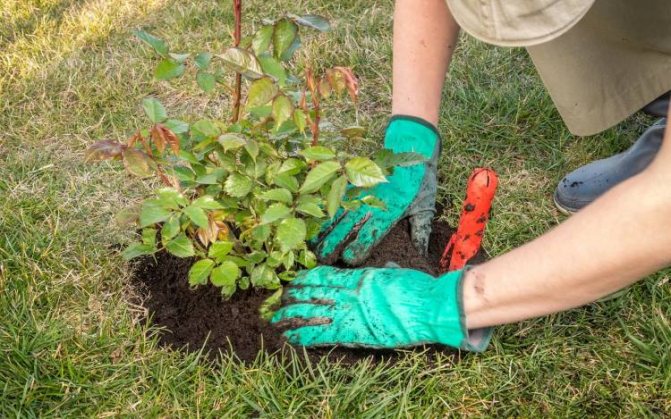

Planting a rose in the soil should be very gentle.
Humidity
The air should not be dry, so it is better to use a spray bottle to periodically spray the leaves of the plant. It is enough to carry out it twice a day. If the plant is located in a cool place, you can skip daily spraying, but you can take a short shower to remove dust from the leaves. In sunny weather, it is better not to spray so as not to provoke rotting.


The air should not be dry, so it is better to use a spray bottle to periodically spray the leaves of the plant.
Why does a rose bloom at home
Each variety of rose bush blooms and fades at a specific time. Usually florists do not see any mysticism in the appearance and opening of buds, however, if a plant blooms unexpectedly, then this may mean the following:
- When hibiscus blooms later or earlier in the home, the owner of the flower should prepare for serious misfortunes. Some esotericists even believe that the appearance of buds on a Chinese rose at the "wrong" time warns of death threatening the owner or someone close to him.
- If the buds suddenly bloom on a bush of an ordinary room rose (tea or cordana), then this is a happy omen. If such an event occurs in the house of a lonely girl, it means that soon she will meet love, her loneliness will end. If the flowers are blooming in a married couple, then it is interpreted as follows: at first there will be small disagreements between the wife and husband, but soon the spouses will make up, and their marriage will become even stronger.
Rose is an extremely capricious plant with a wayward character. It is believed that if she likes a person's dwelling, then she will fill the house with love; if not, it will begin to draw vitality from the owner.
Esotericists advise: before growing a rose bush in an apartment, you should bring a single flower home. If a person's condition worsens in a few days after that, then it is better to listen to the signs and not grow roses at home. If nothing bad happens, then the flower liked the new house - it can be safely grown, the rose bush will become a reliable protection for the owner from enemies.
Care errors
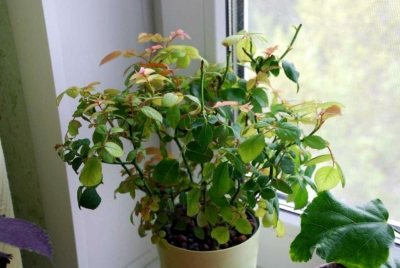

Rose belongs to finicky plants.... Therefore, untimely leaving can lead to the following unpleasant consequences:
- Falling leaves due to improper watering and nutrition.Change the schedule of water and fertilizing.
- Root decay due to excessive watering and keeping in a cold room. The plant is rearranged to a warmer place, water is brought in in small portions, and must be drained from the pallet.
- The buds fall off and wither due to insufficient watering and low humidity. They begin to spray the rose and water it more often.
Also, if the plant is not pruned before wintering and not replanted if necessary, this leads to a slowdown in growth and cessation of flowering. Therefore, carrying out these procedures is a mandatory process.
Shrub rose is an ornamental plant that looks great in any room. It is enough to water it on time, provide the necessary lighting and a dormant period, regularly fertilize, transplant, cut, and then it will delight you with its beautiful flowering for a long time.
If you find an error, please select a piece of text and press Ctrl + Enter.
Home rose: care, tips and tricks
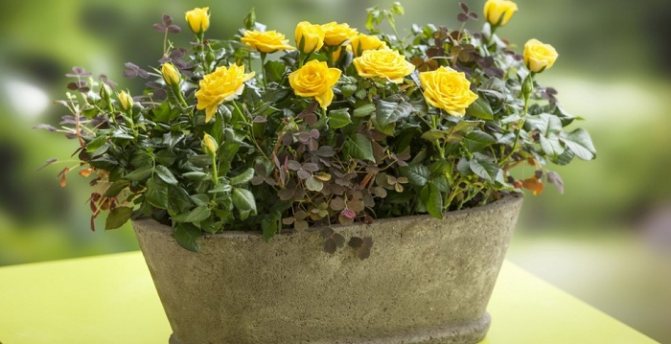

In the gardens of experienced florists, you can often see wildly blooming roses, which delight the eye with their perfect beauty. These plants are quite capricious, because either real professionals or amateurs who have enough time and inspiration to pay special attention to flowers are taken for their cultivation. Home roses in pots of cramped and stuffy city apartments are much less common, because they require a special approach, careful care and special conditions so that incredibly beautiful, fragrant inflorescences eventually appear on the bushes. However, many people have a desire to grow these flowers, therefore it is worth talking about whether it is possible to grow a rose on a balcony or windowsill, what you need to know and be able to do, and what conditions this capricious beauty requires.
Tips for choosing varieties
As for the choice of roses for planting, then here is the best resistant varieties are suitable to common diseases of roses. An excellent option would be grandiflora roses, floribunda, miniature and hybrid tea varieties (for example, Queen Elizabeth or Rose Gaujard).
For planting in winter, species are better suited, not needing abundant lighting: Zorina, Geheimrat Duisberg and Better times. For growing Dutch roses in greenhouses, varieties such as Aqua, Freedom, Magic, Versilia and a number of others are suitable.
Preparing rose cuttings
To do this, you need already cut roses, which you can buy at the store.
For the first stage of work, you should arm yourself with a sharp scissor knife. This will prevent unnecessary injury to the cut stems.
Before using the instrument, it must be disinfected to prevent contamination of the planting samples.
It is also necessary to cut off the unopened buds, and then cut the stems into cuttings 15 to 30 cm long.
The technique of the procedure is as follows: under the lowest kidney, an oblique incision is made with a depression of 1 cm, then a straight incision is made above the kidney located above it.
As a result, you need to get stem segments, each of which contains 2 to 3 future shoots.
At the level of the obtained planting material, the lower leaves are removed, and the upper leaves are shortened by 1/3.
This procedure will help to retain moisture, eliminate drying out of the shoots.
Breaking all the leaves is not recommended as this can affect the circulation of the sap.
The last thing to do is get rid of the thorns on the stem.
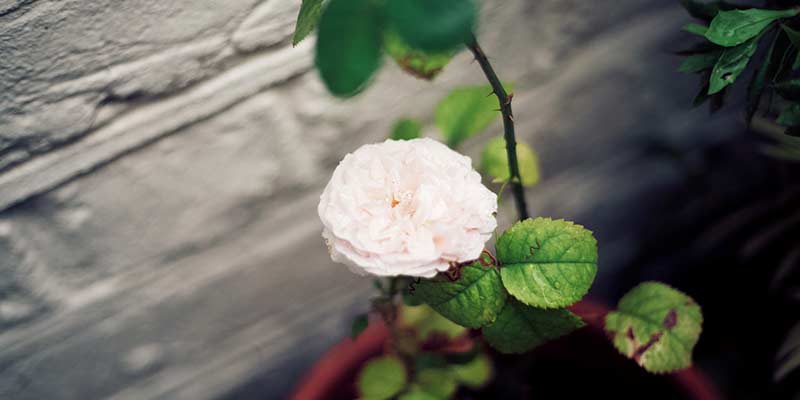

Further care
When growing a purchased rose, you need to provide it with competent care, as this will allow you to achieve long flowering. This plant loves light at any time of the year, so it grows most comfortably on the south or east side. However, it is worth remembering that direct sunlight should not hit the plant so as not to burn the leaves.
In summer, when the sun is especially active, it is best to put the flower on a stand and slightly cover the blinds or curtain.In autumn and winter, additional lighting will be required, so you need to use a table lamp or a special seedling lamp. The distance between it and the plant should not be less than 40 cm.
The rose will grow well only under the right conditions. This flower loves moisture, but does not tolerate heat at all. Indoor humidity should be 50-60%. Higher values can provoke the formation of fungus, as a result of which the flower may die.
Note! In the summer, it is recommended to spray the flower daily with water at room temperature, and if possible, you can plant the plant in open ground.
The optimum temperature for rose growth should be 16-22 ° C, in winter - 8-15 ° C, which is why you can take the plant out to the glazed balcony. Growing a rose is not so difficult, however, if the care of the plant is not followed, it can get sick and die.
This flower loves moisture
In the hot season, watering should be done daily. By autumn, the amount of watering is reduced. In winter, it is enough to water the rose 1-2 times every 10 days. By spring, the frequency of watering is gradually increased. Approximately 0.5 liters of water must be poured into the soil, and after 30 minutes, the residues are removed from the pan so that the liquid does not stagnate and infection and fungi do not multiply in it.
Seat selection
Household roses are light-requiring, so the best place for them is a windowsill on the south or southwest side of the house. In summer, it is better to take the pots out into the air, and if this is not possible, then the plants need to be shaded from the sun. If this is not done, the leaves and petals may get burned, and flowering will occur at an accelerated rate, which will not have the best effect on the decorative effect of the rose. In addition, about once a week, the pot on the window must be rotated, which will ensure even development of the crown.
How to care for a rose?
The flower is quite capricious. Needs the creation of certain conditions of detention. Knowing how to care for a home rose after purchase or for a bush rose, there is every chance to prevent the appearance and development of ailments. The time and effort spent growing this beautiful crop will be rewarded. The bush will delight you with exuberant flowering and fragrance.
In one place, a rose can grow up to 10 years. It is important to choose a site that will best suit the culture. It is desirable that the place is well protected from the wind, sunny, with fertile soil.
Here's how to care for roses to get a beautiful flower:
- Carry out pruning.
- Loosen the soil.
- Mulch the soil.
- Fertilize the ground.
- Irrigate.
Pruning a flower crop
It involves caring for roses in the spring in the country pruning. In spring, the phase of active growth begins: the stems thicken and get stronger, green leaves appear, and buds are formed. But sometimes the summer resident notices shoots that look thin and undeveloped. The reason for this is spring frosts. Calcium deficiency also has an effect. You need to get rid of such escapes. They are cut into two sheets. And after the procedure, the rose is fed with liquid manure or minerals.
Loosening the soil of the rose
Before caring for a home rose, it is important to familiarize yourself with such a procedure as loosening. The main goal is to provide access to heat and air to the root system of the shrub. Work begins in May. And in July-August they stop loosening. Loosening is especially indicated in hot weather, immediately after irrigation.
Mulching crops in spring
It involves caring for roses in the spring in the country and mulching the surface around the bush. Humus, peat, or peat-manure compost are used for this purpose. Pour a layer up to 10 centimeters. This procedure allows you to reduce the number of watering, reduce the need for loosening. Mulching improves the physical and chemical properties of the soil, promotes good growth and crop development.
Fertilizer for roses
Before taking care of roses, it is worth understanding what nutrients this elegant flower requires. Indeed, sometimes the soil lacks useful elements. Then the condition of the bush begins to deteriorate. In the first year after planting, three additional dressings are carried out during the summer. At different times of the year, the plant needs different nutritional components.
There are different options for what you can feed the roses in the garden. The combined use of organic and mineral substances gives a good effect. Organic matter improves the structure of the soil, stimulates the growth of culture. It is important to consider that minerals work more slowly. Understanding how to care for roses in spring, in what proportions to use minerals and organic matter, there are high chances of growing a luxurious flower.
Irrigation: features and norms
The lack of water is painful for roses. The lack of moisture immediately affects the condition of the flower, the growth of shoots. Roses not watered in time wither, leaves begin to crumble, the decorative beauty of the bush disappears. The plant especially needs water during intensive development: when the first shoots are formed, the buds begin to bloom, the first leaves appear. After the first flowering is completed, the irrigation frequency should also be increased.
Experienced gardeners are advised to use rainwater, melt water for irrigation. Rose is a very delicate garden flower. Irrigate with a watering can. Some people use a spray gun. The stream of water is directed to the base of the bush. The procedure is performed gradually, in several approaches. One plant takes about 15 liters of water. The main thing is to avoid getting moisture on the leaves.
Bengal roses
A feature of this type of roses is the absence of the need for a rest period. Plants bloom almost all year round. Varieties of this type are unpretentious and compact. Plant height does not exceed half a meter.
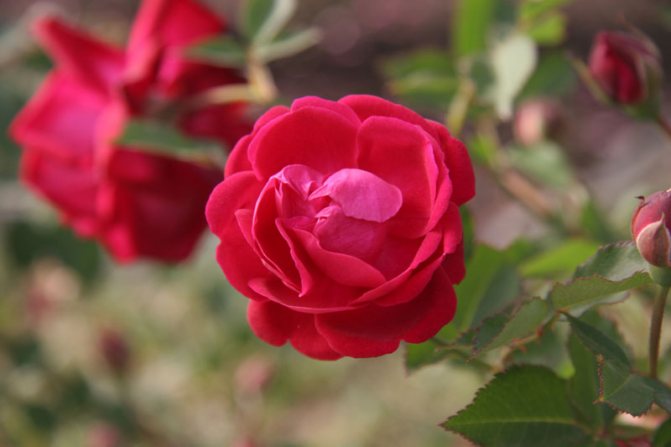

Plants bloom almost all year round.
The flowers of the plant, like the foliage, are small enough, but have a pleasant aroma. In terms of color, flowers can be pink, red or white.
Is it possible to keep a rose at home
There is no consensus among esotericists about whether it is worth growing this flower in an apartment. Some believe that it has a positive effect on the overall aura of the house, bringing calmness, comfort and coziness to the home, filling it with an incomparable, wonderful aroma. Others are sure that the plant is an energy vampire that draws energy from a person, especially when it blooms.
Many people think that growing roses at home is a bad omen, and they cannot be kept in an apartment. In contrast to the latter opinion, florists and bioenergy specialists are convinced that the rose is an absolutely safe flower, perfectly cleansing the atmosphere in the room and having a beneficial effect on the owner's mood.
The general conclusion is that keeping a rose bush at home is not prohibited. True, a lot here depends on the relationship between family members and on what varieties are grown.
Tea, Bengal, Polyanthus roses
These plant varieties are closest to the flowers sold in the flower markets. Grown on a windowsill, rose bushes reach half a meter in height, and the buds have a wonderful smell. It is believed that such roses have a feminine energy, perfectly smooth out family conflicts, fill spouses with tenderness, and give inspiration to creative people.
The plant is credited with the magical ability to resist the negative energy of strangers. Therefore, having grown a tea or Bengal rose bush at home, you can get a powerful natural amulet against the evil eye, which will reliably protect the home owners from ill-wishers.
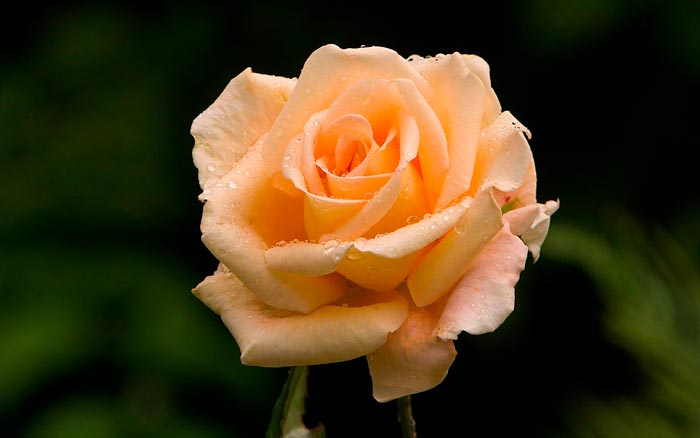

Cordana mix
A small bush with lush numerous buds is very popular with flower growers. Rose cordana mix is the progenitor of all miniature home rose bushes. The flower has the same magical and energetic properties as the varieties described above. The advantage of such a plant is its size - the bush grows no higher than 30 cm.Minus - its beautiful buds do not smell at all or have a very weak aroma.
Esotericists recommend growing varieties with red or pink buds. This will improve the atmosphere in the home, and will soften disagreements and conflicts.
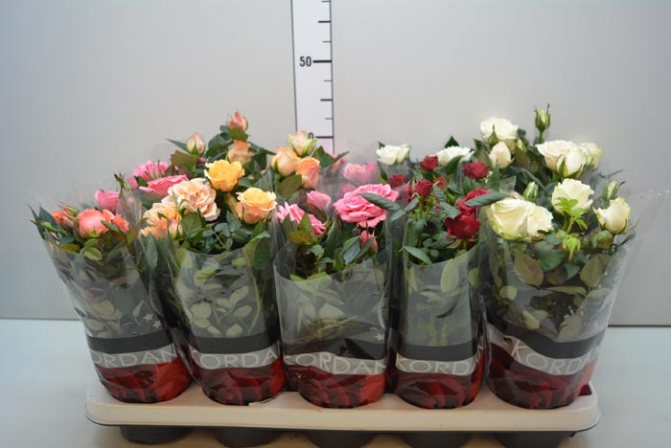

Hibiscus
The Chinese rose hibiscus has a masculine energy. Unlike ordinary varieties that give the owners tenderness and love, this plant fills the residents of the house with courage, determination, and pushes them to actively achieve their goals. It is recommended to start hibiscus for passive people, whom this flower will "stir up", make them cope with natural laziness.
Esotericists advise to grow a plant in a house where one of the family members is a despot. Hibiscus is able to absorb the excessive aggressiveness of the tyrant and protect other residents from his anger, to protect the family from decay. According to another sign, the Chinese rose repels men, so it should not be grown by single women who want to find a second half.
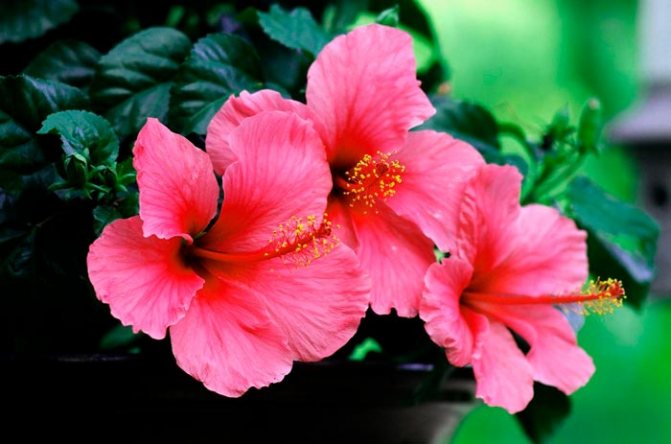

How to protect a rose from diseases and insects?
Sometimes the culture is affected by pests and various ailments. They negatively affect the condition of the bush. And then the question arises, how to revive the rose, how to protect it from negative factors?
To protect the plant, you need to take appropriate sanitary and preventive measures.
Inspection is required periodically. Noticing any changes on the bud, petal or leaves, the damaged part is cut off, and the rose is sprayed with special preparations.
The culture is susceptible to various diseases. For example, rose powdery mildew, rust, gray rot often overcomes. Often you can notice an infectious burn, the appearance of spots on the foliage. Among pests, the following are especially dangerous:
- Spider mite.
- Gall mite.
- Rose sawfly.
- Cicadca.
- Leaf roll.
- Aphid.
To avoid the development of rose disease, the plant should be placed in the correct location. The soil must be chosen fertile. However, even the strongest varieties cannot be insured against the appearance of ailments and pests. And the weather plays a significant role here. For example, if the summer is very rainy or dry, the bush is likely to get sick. In this case, everything depends on the grower, his experience. With the right content, the rose grows and develops usually without problems. Therefore, most often it makes sense to look for the reason why the rose does not bloom in the peculiarities of plant care.
How to germinate a rose using potatoes
You will need:
- potatoes
- rose stem
- 1 plastic bottle
- 1 pot
- 1 knife
What do we have to do:
Make a hole in the center of the potato with a knife.
Now place the stem of the rose in the hole.
Fill the pot with soil and leave a hole in the middle to plant the pink-stemmed potatoes.
Now cut off the bottom of the plastic bottle and close the stem to it, you get a kind of greenhouse.
Then sprinkle the base of the bottle with earth.
Water this structure every day for a week, in a week you will get a stem with already blossoming leaves.
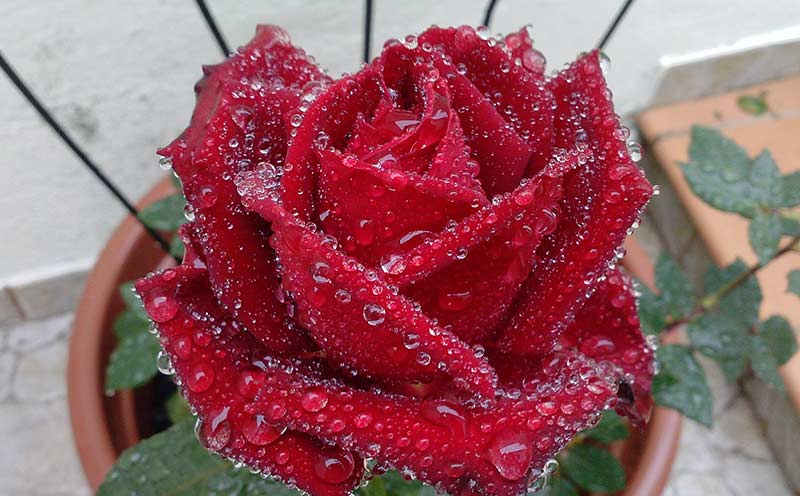

Types for indoor cultivation
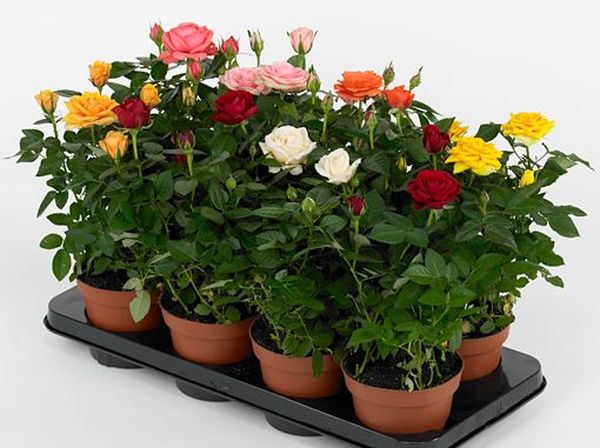

In a pot culture, as a rule, undersized or miniature roses are grown, represented by several varietal groups:
- Bengal roses. They are not found in the wild, so there is an assumption that they were artificially bred specifically for home cultivation. Roses were brought to European countries as early as the 18th century. The bushes are undersized (up to 50 cm), the leaves are small and narrow, the buds are terry, of a different color palette, except for yellow shades. Long bloom - from spring to New Year. Plants do not need rest and do not shed their leaves for the winter.
- Miniature Chinese. This is a dwarf form of the same Bengal roses, distinguished by very small flowers (1-2 cm in diameter). They were brought to Europe at the beginning of the 19th century. Bushes are low (15–25 cm), dense, leaves are small and delicate, buds are densely double.
- Mini flora or patio.A relatively new group of varieties that occupies an intermediate position between Floribunda and miniature roses. It is a multi-flowered low-growing plant that blooms profusely almost all year round. Patio roses are believed to have been bred by Irish breeders in the 1980s. Today it is one of the most promising trends in pot culture and landscape design.
- Polyanthus roses. They were obtained by crossing dwarf multi-flowered roses with hybrid tea forms at the end of the 19th century. Their height is only 30-40 cm, the bushes are compact, dense and very decorative. Buds can be of different sizes (3-5 cm) and color palette, with the exception of yellow.
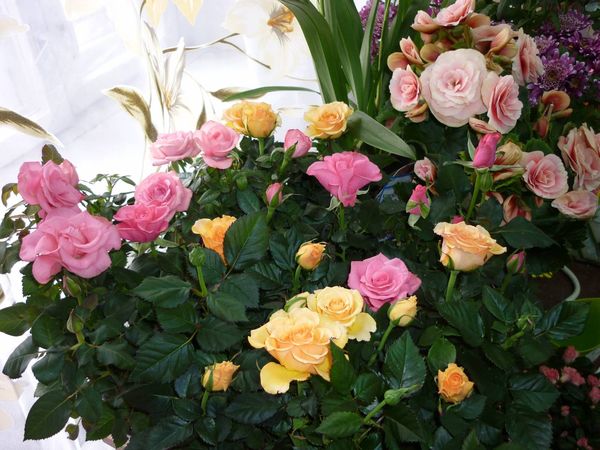

Standard rose in the apartment. Stamp rose do it yourself
Roses that grow in the form of trees have long adorned European cities. Gradually, this novelty came to our open spaces. Today, many gardeners are interested in how to grow a standard rose with their own hands, which are so popular in aristocratic houses.
Standard roses, as a species, are not classified - this is not a tree, but a hybrid of a garden rose grafted onto a rosehip stock. You can plant almost any as a bush or standard method.
The advantages of rose trees include the ability to form unusual bouquets in small areas of the garden, combining standard, ground cover and bush forms. An important criterion for the popularity of boles is the stability of ki, as well as simple care for roses.
Standard roses. Views
Since there is no official classification, these trees are conventionally divided into groups depending on the height of the stock (excluding the crown):
- Low (dwarf) - the height of the trunk is from 30 to 50 cm. They are decorated with driveways, garden paths, terraces, balconies. These roses feel good in containers.
- Half-stems - trunk height up to 80 cm. Suitable for small gardens, in the form of tapeworms they decorate closed recreation areas (patios, patios).
- Ordinary stems are trees up to 1.3 m high. For grafting, varieties of hybrid tea roses or floribunda are used.
- High-standard (weeping) - can reach 3 m in height. They give an aristocratic look to the ceremonial areas of the site, and are planted in large gardens. Climbing varieties of roses are used for grafting.
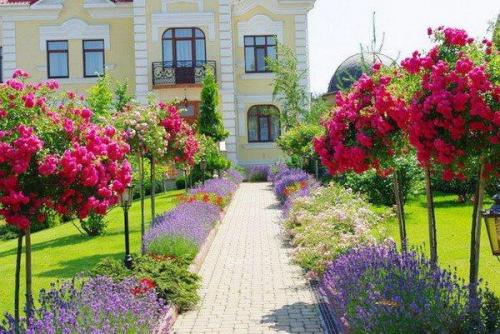

Varieties of stock roses
In modern breeding, three main groups of rootstocks can be distinguished, which are used to form standard roses:
1. The Caninae is the most common section, with conflicting species characteristics:
- Rosa canina is a species used since 1824. On the one hand, the stock itself does not reproduce well and grows slowly, but it belongs to long-livers. It does not differ in high winter hardiness, but hybrid tea roses grown on it tolerate frost well;
- Heinsohn's Record - used in Germany for grafting yellow roses, the advantage is the ability to activate low-growing grafts;
- Pfander's Canina (the most winter-hardy) - well suited for almost all varieties of garden roses, except for some yellow varieties of the hybrid tea class.
2. In the section The Synstylae, only two types of rootstocks (Moschata floribunda and Multiflora) were selected, which are used for vigorous varieties of roses. They are distinguished by unpretentiousness, adaptation to poor sandy loam soils, high disease resistance and cold resistance.
3. The Indicae section is known from the stock Odorata 22449. This species is suitable for countries with mild climates, but it is indifferent to both drying out and waterlogging. Almost all varieties of garden roses take root on it. Subspecies Moore's Odorata, bred later, is more winter-hardy.
Views
There are many forms and varieties of roses.... The most popular are the following types.
Hummingbird
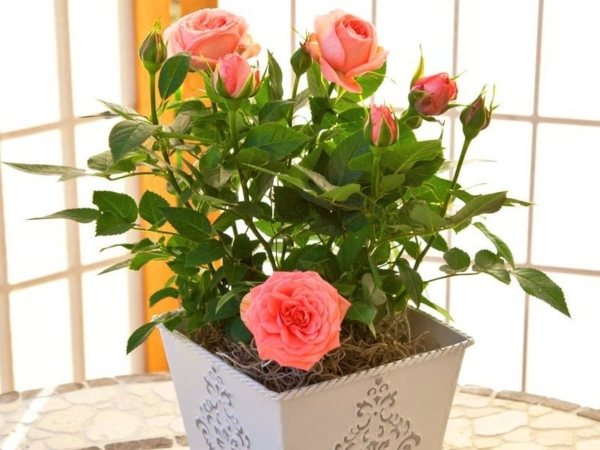

Bushes are dense, branched shoots, leaves are dense, shiny, dark green.
Yellow-orange rose flowers... Lush flowering.
We offer you to watch a video about the hummingbird rose:
Green Ice
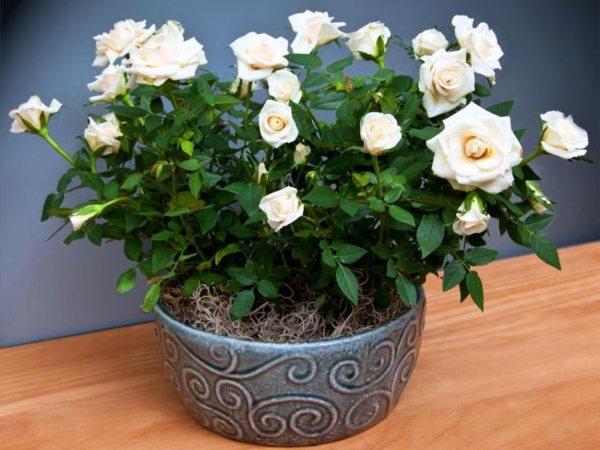

Bushes are wide. The leaves are dark green, dense. The flowers are white with a green tint.
Los Angeles
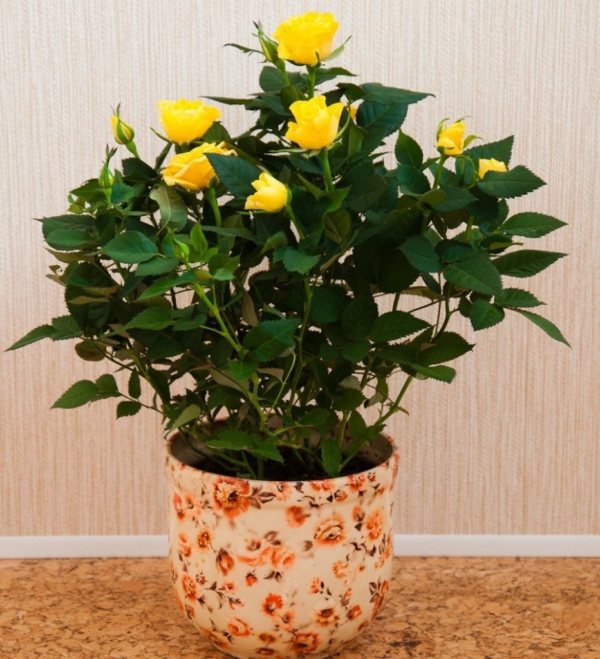

Rose bushes grow up to 40 cm, abundantly covered with buds... Stems are straight, smooth. The color of the inflorescences changes from lemon yellow to coral.
Rose has always deservedly been considered the queen of flowers. You can admire it not only in flower beds, but also at home. Read about the secrets of growing varieties such as mix, dwarf and Cordana on our website.
Photo
See how a greenhouse with flowers looks like in the photo below.
Growing conditions
Since the plant is not tropical, it needs moderate living conditions. So, let's figure out how to care for a home rose so that this beautiful flower becomes a real decoration of your interior.
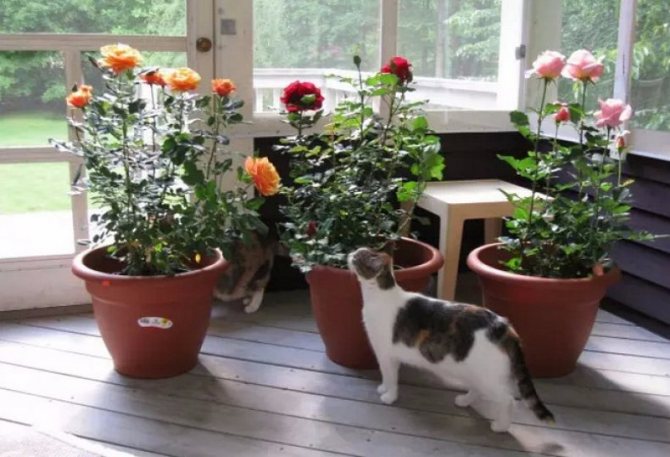

Temperature and humidity
Temperatures should be moderate in summer and cool in winter. At home, miniature roses suffer not so much from high air temperatures as from overheating or drying out of the soil in the container. The optimum temperature for keeping in the summer is + 20-25 ° C. However, slight daily temperature fluctuations will only benefit the plant.
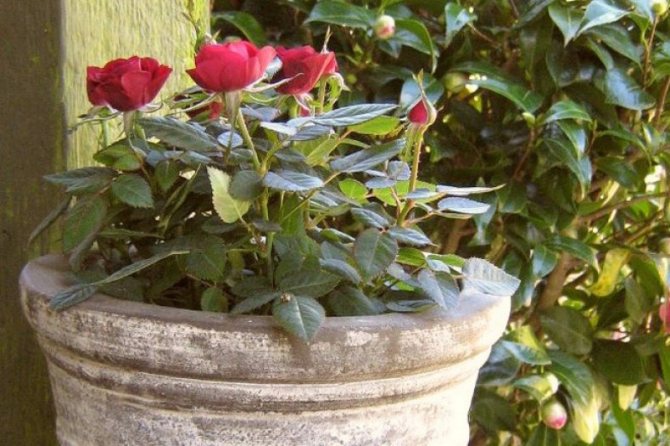

In winter, in order for the rose to rest, it is transferred to a cool place with a temperature of + 10-15 ° C.
As for the humidity of the air, humid air is preferable for a room rose. In a too dry environment, the bushes can become infected with parasites. Therefore, spray regularly (every two days). If the bushes are in a cool room, then they do not need frequent spraying. And to remove dust from the leaves, you can arrange a short warm shower.
Lighting
The domestic rose, like most ornamental plants, is a photophilous crop. At the same time, overheating of the bushes should not be allowed, therefore it is customary to place them on the southeast or west window. In order to protect the flower from direct sunlight in the summer season, it is better to take it out into the open air (balcony or terrace).
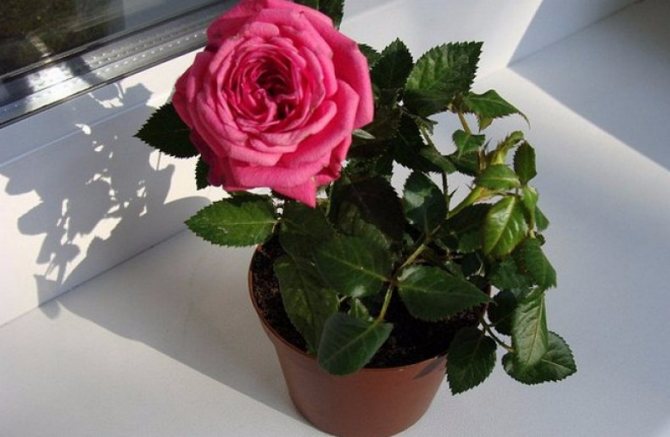

If this is not possible, then it is advisable to transfer the pot to another window or darken it.
Pot and soil
Roses can be planted in containers of all shapes and sizes. The only condition is that there must be enough space in the container so that the bush can develop and the air can circulate freely. You are required to find a compromise between beauty and functionality.
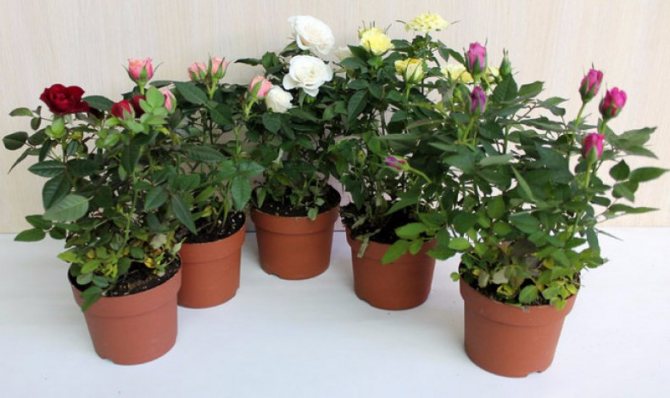

It is advisable to transplant overgrown bushes into a larger container. When choosing a pot, the color of the flowers and the style of the surrounding interior should also be taken into account. By the type of container, wooden or ceramic pots are the best option.
Plastic pots are allowed, but less reliable. The soil in them dries out quickly in summer, which leads to the rapid withering of the buds. It is also better to refuse clay pots - they quickly lose water.
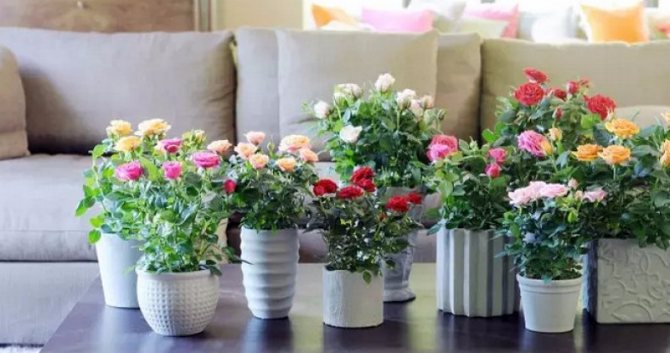

The soil must be air and moisture permeable.
Use the following nutrient medium:
- sod land (4 parts);
- humus (4 parts);
- sand (1 part).
You can also purchase a ready-made specialized substrate.
The pot should have a good drainage system so that excess moisture can freely pass through the soil. However, the size of the drain holes must be such that water does not flow out of the container too quickly.

